Paul van Yperen's Blog, page 404
October 10, 2014
Metropolis (1927)
Today's film special is on the German expressionist film Metropolis (Fritz Lang, 1927). A few years ago, my son and I saw a screening in the Castro theatre in San Francisco of a newly restored version of this science-fiction epic, based on Lang’s original cut of the film. We were both mesmerized by the sheer force and beauty of this silent classic. Everyone should see this film! At the time of the premiere in 1927, Ross Verlag made a series of sepia postcards for Metropolis. These are quite rare now, but thanks to the collections of Didier Hanson and EYE Film Institute in Amsterdam, we can present you this post.
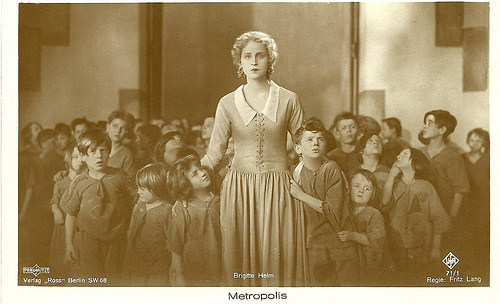
German postcard by Ross Verlag, Berlin, no. 71/1. Photo: Ufa / Parufamet. Publicity still for Metropolis (Fritz Lang, 1927) with Brigitte Helm as the good Maria. Collection: Didier Hanson.
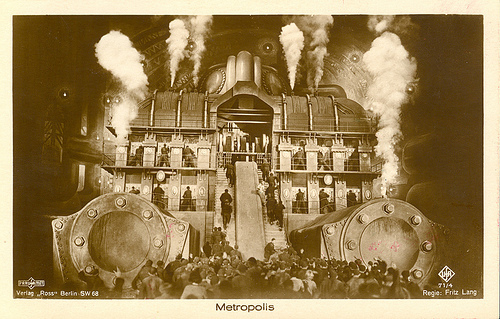
German postcard by Ross Verlag, Berlin, no. 71-4. Photo: Ufa / Parufamet. Publicity still for Metropolis (Fritz Lang, 1927). Collection: Amsterdam EYE Filmmuseum.
The First Science Fiction Feature
The screenplay for Metropolis was written by Fritz Lang and his wife Thea von Harbou. It would become the first feature length film of the science fiction genre.
Metropolis is set in a futuristic urban dystopia. Wealthy industrialists rule the vast city of Metropolis from high-rise tower complexes, while a lower class of underground-dwelling workers toil constantly to operate the machines that provide its power.
The Master of Metropolis is the ruthless Joh Fredersen ( Alfred Abel ), whose son Freder ( Gustav Fröhlich ) idles away his time in a pleasure garden with the other children of the rich.
Freder is interrupted by the arrival of a young woman named Maria ( Brigitte Helm ), who has brought a group of workers' children to see the privileged lifestyle led by the rich. Maria and the children are quickly ushered away, but Freder is fascinated by Maria and descends to the workers' city in an attempt to find her.
Metropolis follows the attempts of Freder and Maria to overcome the vast gulf separating the classes of their city. One of the highlights of the film is the spectacular explosion of a huge machine in the machine rooms, which causes several injuries and deaths.
Another highlight is the creation scene of the Maschinenmensch (Machine-Human), a false Maria, which must ruin Maria's reputation among the workers. The false Maria (also Brigitte Helm ) unleashes chaos throughout Metropolis, driving men to murder out of lust for her and stirring dissent amongst the workers.
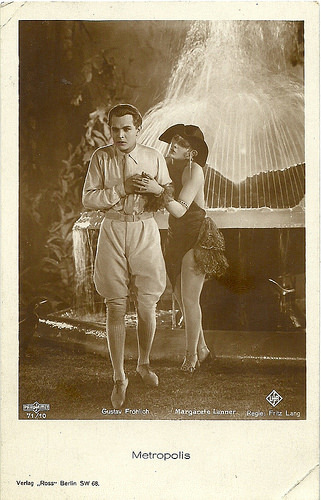
German postcard by Ross Verlag, Berlin, no. 71/10. Photo: Ufa / Parufamet. Publicity still for Metropolis (Fritz Lang, 1927) with Gustav Fröhlich and Margarete Lanner. Collection: Didier Hanson.
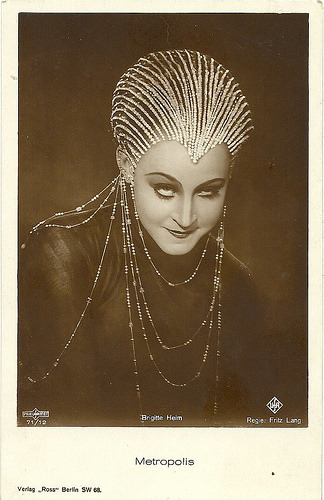
German postcard by Ross Verlag, Berlin, no. 71/12. Photo: Ufa / Parufamet. Publicity still for Metropolis (Fritz Lang, 1927) with Brigitte Helm as the false Maria. Collection: Didier Hanson.
The most expensive film
Metropolis was filmed in 1925, at a cost of approximately five million Reichsmarks. Thus, it was the most expensive film ever released up to that point.
The two leading actors of the film were unknowns: nineteen-year-old Brigitte Helm had no previous film experience.
Gustav Fröhlich had only played secondary roles before landing his breakthrough role as Freder Fredersen. The part came about by chance.
Fröhlich was only scheduled to play one of the workmen but four weeks after the beginning he was discovered on the set by Thea von Harbou. Fritz Lang immediately cast him in the lead because of his striking good looks.
Two new stars were born, but the film itself was met with a mixed response upon its initial release. Many critics praised its technical achievements and social metaphors while others derided its 'simplistic and naïve' presentation.
Because of its long running-time and the inclusion of footage which censors found questionable, Metropolis was cut substantially after its German premiere: large portions of the film were lost over the subsequent decades.
Numerous attempts have been made to restore the film since the 1970s-80s. In 2001, the film was inscribed on UNESCO's Memory of the World Register, the first film thus distinguished.
In 2008, a damaged print of Lang’s original cut of the film was found in a museum in Argentina. After a long restoration process, the film was 95% restored and shown in a limited theatrical re-release in 2010.
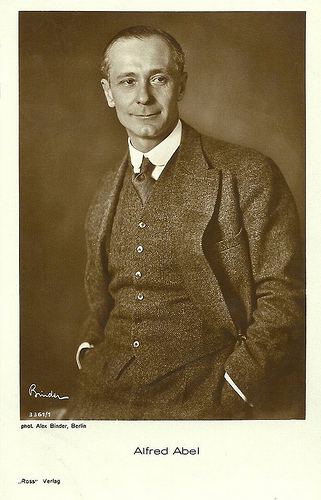
Alfred Abel . German postcard by Ross Verlag, no. 3161/1, 1928-1929. Photo: Alex Binder.
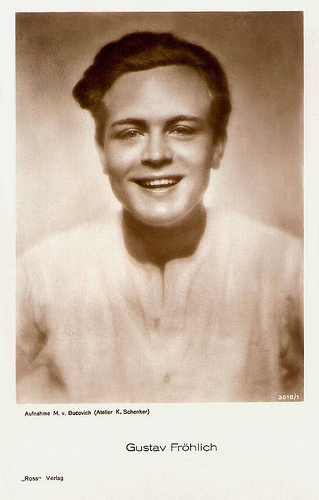
Gustav Fröhlich . German postcard by Ross Verlag, no. 3018/1, 1928-1929. Photo: M. v. Bucovich (Atelier K. Schenker).
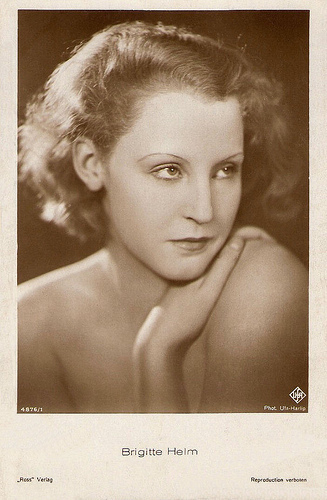
Brigitte Helm . German postcard by Ross Verlag, no. 4876/1, 1929-1930. Photo: Ufa-Harlip.
Sources: Wikipedia and IMDb.

German postcard by Ross Verlag, Berlin, no. 71/1. Photo: Ufa / Parufamet. Publicity still for Metropolis (Fritz Lang, 1927) with Brigitte Helm as the good Maria. Collection: Didier Hanson.

German postcard by Ross Verlag, Berlin, no. 71-4. Photo: Ufa / Parufamet. Publicity still for Metropolis (Fritz Lang, 1927). Collection: Amsterdam EYE Filmmuseum.
The First Science Fiction Feature
The screenplay for Metropolis was written by Fritz Lang and his wife Thea von Harbou. It would become the first feature length film of the science fiction genre.
Metropolis is set in a futuristic urban dystopia. Wealthy industrialists rule the vast city of Metropolis from high-rise tower complexes, while a lower class of underground-dwelling workers toil constantly to operate the machines that provide its power.
The Master of Metropolis is the ruthless Joh Fredersen ( Alfred Abel ), whose son Freder ( Gustav Fröhlich ) idles away his time in a pleasure garden with the other children of the rich.
Freder is interrupted by the arrival of a young woman named Maria ( Brigitte Helm ), who has brought a group of workers' children to see the privileged lifestyle led by the rich. Maria and the children are quickly ushered away, but Freder is fascinated by Maria and descends to the workers' city in an attempt to find her.
Metropolis follows the attempts of Freder and Maria to overcome the vast gulf separating the classes of their city. One of the highlights of the film is the spectacular explosion of a huge machine in the machine rooms, which causes several injuries and deaths.
Another highlight is the creation scene of the Maschinenmensch (Machine-Human), a false Maria, which must ruin Maria's reputation among the workers. The false Maria (also Brigitte Helm ) unleashes chaos throughout Metropolis, driving men to murder out of lust for her and stirring dissent amongst the workers.

German postcard by Ross Verlag, Berlin, no. 71/10. Photo: Ufa / Parufamet. Publicity still for Metropolis (Fritz Lang, 1927) with Gustav Fröhlich and Margarete Lanner. Collection: Didier Hanson.

German postcard by Ross Verlag, Berlin, no. 71/12. Photo: Ufa / Parufamet. Publicity still for Metropolis (Fritz Lang, 1927) with Brigitte Helm as the false Maria. Collection: Didier Hanson.
The most expensive film
Metropolis was filmed in 1925, at a cost of approximately five million Reichsmarks. Thus, it was the most expensive film ever released up to that point.
The two leading actors of the film were unknowns: nineteen-year-old Brigitte Helm had no previous film experience.
Gustav Fröhlich had only played secondary roles before landing his breakthrough role as Freder Fredersen. The part came about by chance.
Fröhlich was only scheduled to play one of the workmen but four weeks after the beginning he was discovered on the set by Thea von Harbou. Fritz Lang immediately cast him in the lead because of his striking good looks.
Two new stars were born, but the film itself was met with a mixed response upon its initial release. Many critics praised its technical achievements and social metaphors while others derided its 'simplistic and naïve' presentation.
Because of its long running-time and the inclusion of footage which censors found questionable, Metropolis was cut substantially after its German premiere: large portions of the film were lost over the subsequent decades.
Numerous attempts have been made to restore the film since the 1970s-80s. In 2001, the film was inscribed on UNESCO's Memory of the World Register, the first film thus distinguished.
In 2008, a damaged print of Lang’s original cut of the film was found in a museum in Argentina. After a long restoration process, the film was 95% restored and shown in a limited theatrical re-release in 2010.

Alfred Abel . German postcard by Ross Verlag, no. 3161/1, 1928-1929. Photo: Alex Binder.

Gustav Fröhlich . German postcard by Ross Verlag, no. 3018/1, 1928-1929. Photo: M. v. Bucovich (Atelier K. Schenker).

Brigitte Helm . German postcard by Ross Verlag, no. 4876/1, 1929-1930. Photo: Ufa-Harlip.
Sources: Wikipedia and IMDb.
Published on October 10, 2014 23:00
October 9, 2014
Valerie Boothby
German actress Valerie Boothby (1904-1982) was a popular star of the Weimar cinema in the late 1920s and early 1930s. She often played flappers and femme fatales.
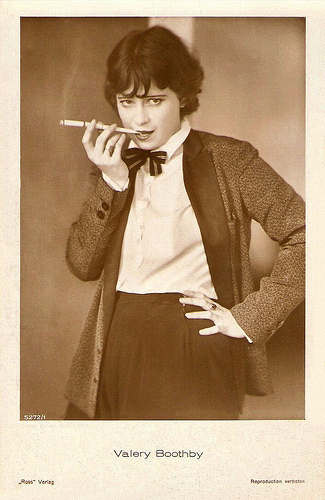
German postcard by Ross Verlag, no. 5272/1, 1930-1931. Photo: Lotte Jacobi.
Heydays of the Silent Cinema
Valerie – or Valery - Boothby was born as Wally Drucker in Hamburg, Germany in 1904 (some sources say 1906). She was the daughter of the Hamburg theater director Ernst Drucker.
She entered the film business in 1925 during the heydays of the German silent cinema. Her film debut was Der krasse Fuchs/The Glaring Fox (Conrad Wiene, 1925).
In the next years she made many other silent films and her popularity increased quickly. Among her films were Die Frau mit dem Weltrekord/The Woman with the World Record (Erich Waschneck, 1927), Das letzte Souper/Theatre (Mario Bonnard, 1928) starring Marcella Albani , and Angst - Die schwache Stunde einer Frau/Fear (Hans Steinhoff, 1928) in which she co-starred with Gustav Fröhlich and Elga Brink .
She embodied popular types at the time as the flapper or the femme fatale.
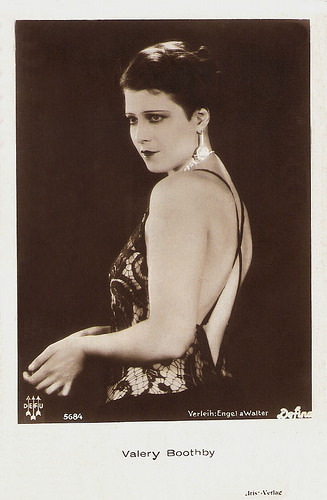
Austrian postcard by Iris-Verlag, no. 5684. Photo: Verleih Engel & Walter / Defina / Defu.
Portait Painter and Author
From 1929 on, Valerie Bootby played on the Berlin stages under Victor Barnowsky and Fritz Rotter.
She continued to appear in such silent films as Der Monte Christo von Prag/The Monte Christo of Prague (Hans Otto, 1929) with Walter Rilla , Frauen am Abgrund/Women on the Edge (Georg Jacoby, 1929) opposite Gustav Diessl, and Mädchen am Kreuz/Girls on a Cross (Jacob & Luise Fleck, 1929).
During the early sound period Boothby made her last films, including In einer kleinen Konditorei/In a Little Confectionery (Robert Wohlmuth, 1930) with French star Jaque Catelain , Er oder ich/He or I (Harry Piel, 1930), and Der Herr Finanzdirektor/Mr. Finance Director (Fritz Friedmann-Frederich, 1931) featuring Max Adalbert.
Her last film was So lang' noch ein Walzer vom Strauß erklingt (Conrad Wiene, 1931) starring Gustav Fröhlich as Johan Strauss Jr.
Then her film career halted. Why is unclear. After the takeover by the Nazis in 1933, she emigrated to France, and she lived for many years in Egypt.
She worked as a portrait painter and was the author of such childrens books as Knurr und seine Bande oder Hunde erobern eine Stadt (Knurr and His Dog Gang Conquer a City) (1954) and Der Katzenkapitän (The Captain of the Cats) (1959).
In 1970 she returned to her hometown of Hamburg. Valerie Boothby died at the age of 75 in Hamburg in 1982.
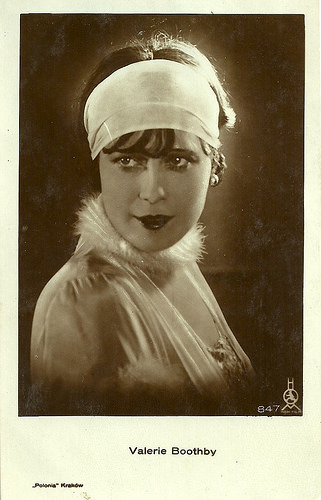
Polish postcard by Polonia, Krakow, no. 847. Photo: Hom Film. Postcard for one of the two Hom productions Boothby played in, either Der Mann, der nicht liebt (Guido Brignone, 1929), starring Gustav Diessl , or Vererbte Triebe (Gustav von Ucicky, 1929), starring Fritz Alberti.
Sources: Thomas Staedeli (Cyranos), Wikipedia (German), and .

German postcard by Ross Verlag, no. 5272/1, 1930-1931. Photo: Lotte Jacobi.
Heydays of the Silent Cinema
Valerie – or Valery - Boothby was born as Wally Drucker in Hamburg, Germany in 1904 (some sources say 1906). She was the daughter of the Hamburg theater director Ernst Drucker.
She entered the film business in 1925 during the heydays of the German silent cinema. Her film debut was Der krasse Fuchs/The Glaring Fox (Conrad Wiene, 1925).
In the next years she made many other silent films and her popularity increased quickly. Among her films were Die Frau mit dem Weltrekord/The Woman with the World Record (Erich Waschneck, 1927), Das letzte Souper/Theatre (Mario Bonnard, 1928) starring Marcella Albani , and Angst - Die schwache Stunde einer Frau/Fear (Hans Steinhoff, 1928) in which she co-starred with Gustav Fröhlich and Elga Brink .
She embodied popular types at the time as the flapper or the femme fatale.

Austrian postcard by Iris-Verlag, no. 5684. Photo: Verleih Engel & Walter / Defina / Defu.
Portait Painter and Author
From 1929 on, Valerie Bootby played on the Berlin stages under Victor Barnowsky and Fritz Rotter.
She continued to appear in such silent films as Der Monte Christo von Prag/The Monte Christo of Prague (Hans Otto, 1929) with Walter Rilla , Frauen am Abgrund/Women on the Edge (Georg Jacoby, 1929) opposite Gustav Diessl, and Mädchen am Kreuz/Girls on a Cross (Jacob & Luise Fleck, 1929).
During the early sound period Boothby made her last films, including In einer kleinen Konditorei/In a Little Confectionery (Robert Wohlmuth, 1930) with French star Jaque Catelain , Er oder ich/He or I (Harry Piel, 1930), and Der Herr Finanzdirektor/Mr. Finance Director (Fritz Friedmann-Frederich, 1931) featuring Max Adalbert.
Her last film was So lang' noch ein Walzer vom Strauß erklingt (Conrad Wiene, 1931) starring Gustav Fröhlich as Johan Strauss Jr.
Then her film career halted. Why is unclear. After the takeover by the Nazis in 1933, she emigrated to France, and she lived for many years in Egypt.
She worked as a portrait painter and was the author of such childrens books as Knurr und seine Bande oder Hunde erobern eine Stadt (Knurr and His Dog Gang Conquer a City) (1954) and Der Katzenkapitän (The Captain of the Cats) (1959).
In 1970 she returned to her hometown of Hamburg. Valerie Boothby died at the age of 75 in Hamburg in 1982.

Polish postcard by Polonia, Krakow, no. 847. Photo: Hom Film. Postcard for one of the two Hom productions Boothby played in, either Der Mann, der nicht liebt (Guido Brignone, 1929), starring Gustav Diessl , or Vererbte Triebe (Gustav von Ucicky, 1929), starring Fritz Alberti.
Sources: Thomas Staedeli (Cyranos), Wikipedia (German), and .
Published on October 09, 2014 23:00
October 8, 2014
Wilhelm Dieterle
Wilhelm Dieterle (1893-1972) a.k.a. William Dieterle was a German actor and director who started out in Weimar cinema, before becoming a well-known Hollywood director.
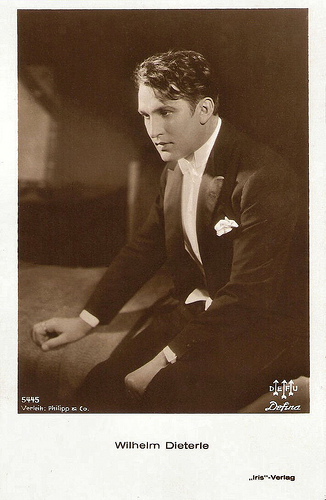
Austrian postcard by Iris-Verlag, no. 5445. Photo: DEFU / Defina / Philipp & Co.
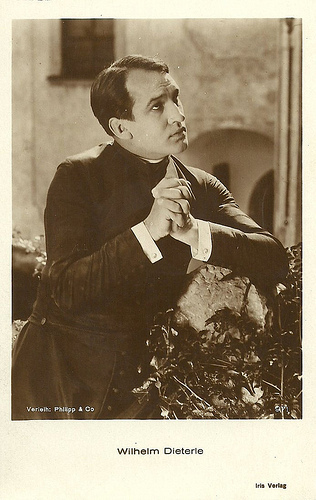
Austrian postcard by Iris Verlag, no. 971. Photo: Philipp & Co. Perhaps a card for the film Das Geheimnis des Abbe X (1927), directed by Dieterle himself, or for Der Pfarrer von Kirchfeld (1926), directed by Jakob and Luise Fleck.
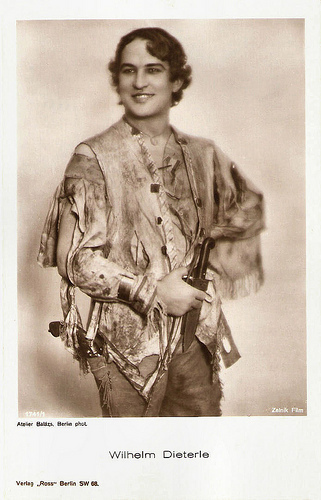
German postcard by Ross Verlag, no. 1741/1, 1927-1928. Photo: Atelier Balazs, Berlin / Zelnik Film.
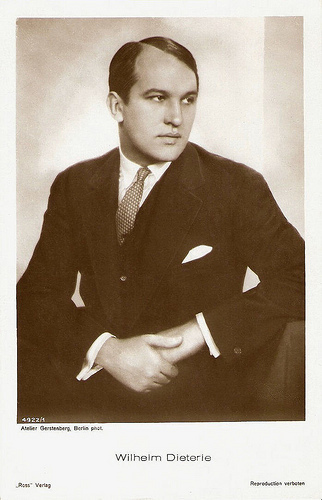
German postcard by Ross Verlag, no. 4922/1, 1929-1930. Atelier Gerstenberg, Berlin.
Kammerspiel
Wilhelm Dieterle was born in Ludwigshafen am Rhein in 1893. He was the youngest child of nine, to poor Jewish parents Jacob and Berthe Dieterle.
He took acting lessons at a young age, and began his career as a stage actor in 1911 at the theatre in Arnsberg. This also included work as an extra, singer, dancer and stagehand; hence his white gloves, which he continued to wear in Hollywood.
His striking good looks and ambition soon paved the way as a leading romantic actor in theatre productions. In 1912-1914 he worked at theatres in Heilbronn, Plauen and Bad Dürkheim, in 1914-1917 in Mainz (under the direction of future film director Ludwig Berger).
In 1917-1918 he played in Zürich, in 1918-1919 in Berlin and in 1919-1920 in Munich. He had his breakthrough in 1920-1923 with Max Reinhardt’s Deutschen Theater in Berlin. In this era he mainly worked there, next to sidesteps with the companies of Leopold Jessner, Viktor Barnowsky and Karlheinz Martin. In 1924 Dieterle had his own theatre company, but it was short-lived.
His first film performance was in the Friedrich Schiller adaptation Fiesko (Carl Hoffmann, Phil Jutzi, 1913). He took up film acting from 1919 on in films like Die Vermummten/The Disguised Ones (Franz Seitz, 1920).
All through the 1920s, he appeared in numerous films. Dieterle appeared in major classics of the Weimar era. He was Henny Porten ’s ill-fated fiancé and Fritz Kortner ’s rival in love in the Kammerspiel Hintertreppe/Backstairs (Leopold Jessner, 1921). Actually, he was often paired with Porten, before Hintertreppe also in Die Geier-Wally/Wally of the Vultures (1921, Ewald André Dupont), and afterwards in Frauenopfer/Women's Sacrifice (Karl Grune, 1921).
Dieterle also was the poet, and the Persian baker and Russian prince in the Harun al Raschid and Iwan the Terrible sequences in Das Wachsfigurenkabinett/Waxworks (Paul Leni, 1923-1924). He played Henny Porten’s young husband in the internationally popular Mutter und Kind/Mother and Child (Carl Froehlich, 1924). And he played Gretchen’s brother Valentin in Friedrich Wilhelm Murnau’s Faust (1926), who was killed by Mephisto.
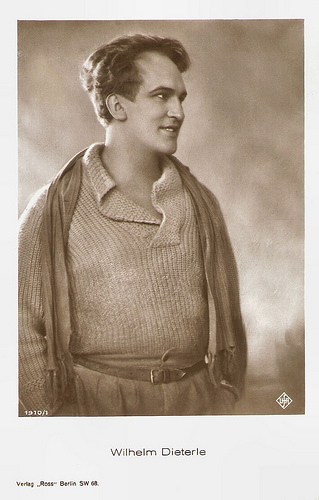
German postcard by Ross Verlag, Berlin, no. 1910/1, 1927-1928. Photo: Ufa.
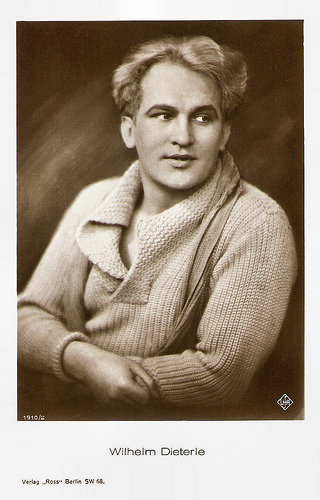
German postcard by Ross Verlag, Berlin, no. 1910/2, 1927-1928. Photo: Ufa.
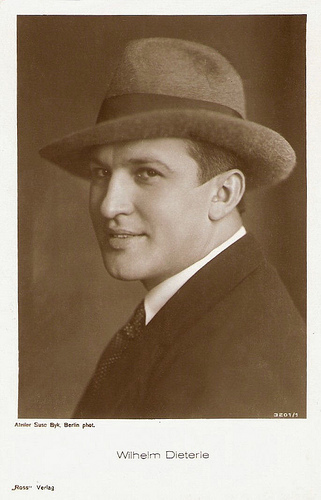
German postcard by Ross Verlag, no. 3201/1, 1928-1929. Photo: Atelier Suse Byk, Berlin.
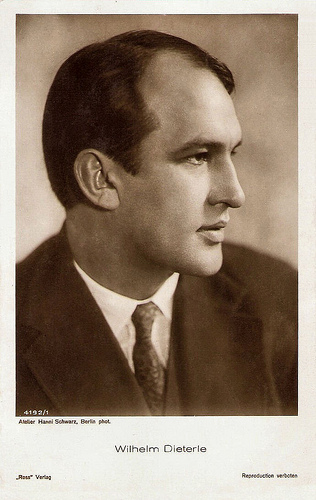
German postcard by Ross Verlag, no. 4192/1, 1929-1930. Photo: Hanni Schwarz, Berlin.
Sex in Chains
From 1923 on, Wilhelm Dieterle directed his first films, in which he always played the lead. He started with the Heimat-film Der Mensch am Wege/Man by the Roadside (1923), in which Marlene Dietrich played one of her first roles.
The major example of his own output was Geschlecht in Fesseln/Sex in Chains (1928), one of the films produced by his own company Charha (1927), which he ran with his wife, scriptwriter and actress Charlotte Hagenbruch. Dieterle played a man who accidentally kills another man who tried to harass his wife (Mary Johnson). In jail he is seduced by an inmate, while his wife gives in to another man as well. After his liberation, the couple feel guilt and commit suicide.
In particular between 1928 and 1930, Dieterle directed many films for his own company, in which he starred and for which his wife signed the script, such as the melodrama Die Heilige und ihr Narr/The Saint and Her Fool (1928) with Lien Deyers and Gina Manès , and the mountain film Das Schweigen im Walde/The Silence in the Wood (1929).
His German films were so successful internationally, that he was offered a contract by Warner Brothers in 1930 to make German versions of American sounds films for Deutsche First National Pictures GmbH (Defina), the German department of Warner’s subsidiary First National.
His first, The Last Flight (1931) with Richard Barthelmess, was a success and has been hailed as a forgotten masterpiece. Another example was Die heilige Flamme/The Holy Flames (1930-1931), co-directed with Berthold Viertel and starring Salka Viertel.
In the States, Dieterle stopped with acting and focused on directing under the name William Dieterle. As he was Jewish, he was lucky to get away from the slowly worsening situation in Germany. Three years later Adolph Hitler would take over and ban all Jews from the German film industry.
In the US, Dieterle quickly adapted and was permitted to start directing his own films. With Michael Curtiz, Dieterle soon became the regular Warner film director, working in every possible genre, such as comedies with Kay Francis and the melodrama The Crash (1932) with Ruth Chatterton.
Together with Max Reinhardt, with whom Dieterle had worked in Germany, he adapted A Midsummer Night’s Dream (1935) for the cinema, but the result failed to convince the critics.
In the early 1930s, Dieterle was highly productive for Warner, turning out 6 films per year in 1933 and 1934. He probably had to: in 1933 he had received a seven-year contract from Warner.
From the mid-1930s on, Dieterle became well-known for his bio-pics. The Story of Louis Pasteur (1936) won him an Oscar nomination while The Life of Emile Zola (1937) got him the Oscar. In both films Paul Muni played the lead.
Other memorable titles were the Mark Twain adaptation The Prince and the Pauper (1937) with Errol Flynn, Juarez (1939) with Bette Davis, and The Hunchback of the Notre Dame (1939) with Charles Laughton as Quasimodo.
In 1937 Warner offered Dieterle, by now an American citizen, the opportunity to study Russian production methods during four months at Lenfilm in Moscow. In 1938-1940 he taught theatre lessons at the Max Reinhardt Workshop of Stage, Screen and Radio, and in 1939 he co-founded the antifascist cultural magazine The Hollywood Tribune and the English spoken exile theatre company The Continental Players, directed by Leopold Jessner.
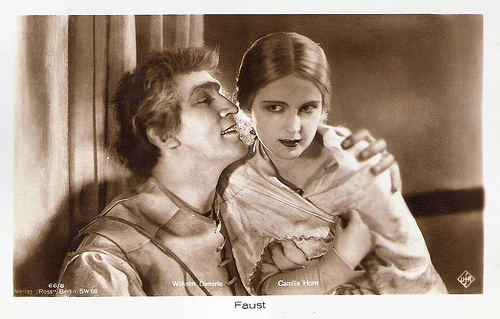
German postcard by Ross Verlag, no. 66/4. Photo: Ufa. Publicity still for Faust (1926) with Camilla Horn .
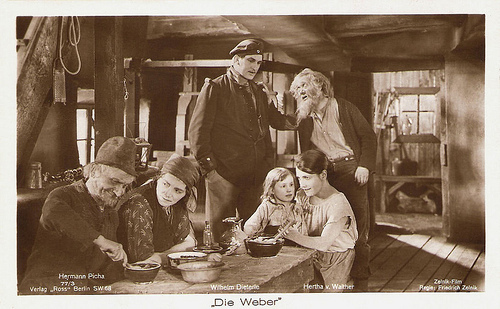
German postcard by Ross Verlag, Berlin, no. 77/3. Photo: Zelnik-Film. Publicity still for Die Weber (Friedrich Zelnik, 1927) with Hertha von Walther and Hermann Picha.
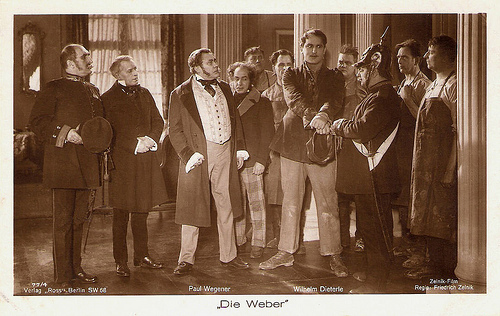
German postcard by Ross Verlag, Berlin, no. 77/4. Photo: Zelnik-Film. Publicity still for Die Weber (Friedrich Zelnik, 1927) with Paul Wegener .
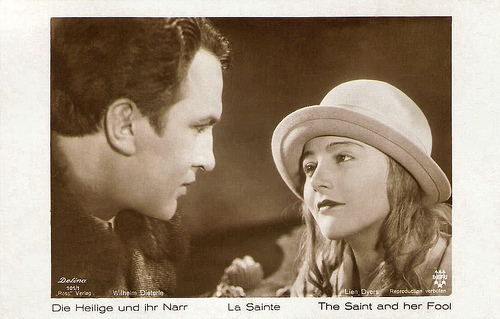
German postcard by Ross Verlag, no. 101/1, 1927-1928. Photo: Defina / DEFU. Publicity still for Die Heilige und ihr Narr/The Saint and her Fool (Wilhelm Dieterle, 1928) with Lien Deyers .
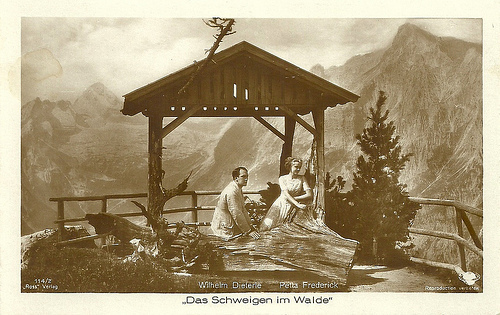
German postcard by Ross Verlag, no. 114/2. Photo: Deutsche Universal-Film. Publicity still for Das Schweigen im Walde/The silence in the forest (Wilhelm Dieterle, 1929) with Petta Frederick.
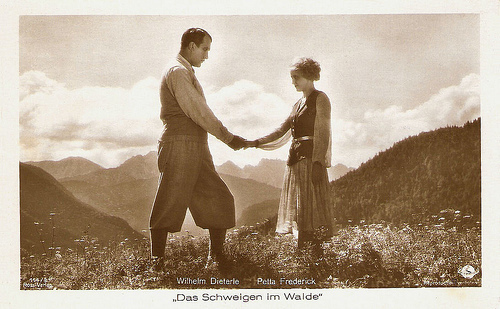
German postcard by Ross Verlag, Berlin, no. 114/3. Photo: Deutsche Universal-Film. Publicity still for Das Schweigen im Walde/The silence in the forest (Wilhelm Dieterle, 1929) with Petta Frederick.
Romantic, Lush Melodramas
After his contract with Warner expired, Wilhelm Dieterle broke with them and tried his own film company at RKO. When that failed, he mainly made films with MGM, Selznick and Paramount.
During the 1940s, Dieterle focused on romantic, lush melodramas such as the Technicolor extravaganza Kismet (1944) with Ronald Colman and Marlene Dietrich , and Love Letters (1945) and Portrait of Jennie (1948), both with Joseph Cotten and Jennifer Jones. Love Letters became an enormous success and earned Jones an Oscar.
In the 1950s, Dieterle’s career declined during the McCarthyism period. In 1950 he went to Italy to shoot Vulcano, a rival to Roberto Rossellini’s Stromboli. When Anna Magnani heard that her former lover planned to make a film with his new girlfriend Ingrid Bergman on an Italian island near Sicily, Magnani pushed a Sicilian producer to make a rivalling film which had to come out before Rossellini’s. The affair was known as ‘la guerra dei vulcani’, also referring to Magnani’s tempestuous character.
Around the same time, Dieterle also shot in Italy the highly romantic September Affair (1950), with Joseph Cotten and Joan Fontaine. After he had returned to Hollywood, Dieterle made crime films like Dark City (1950) with Charlton Heston, Boots Malone (1952) and The Turning Point (1952), both with William Holden.
He also filmed epic melodramas such as Salome (1953), starring Rita Hayworth and partly shot in Jerusalem, and Omar Khayyam (1956), starring Cornel Wilde and shot in the Bronson Canyon.
In 1958 Dieterle returned to Germany and worked till his death as a stage director for various companies in Germany, Switzerland and Austria; he also worked for German (Sender Freies Berlin) and Austrian television and (co-)directed two features: a remake of Joe May’s classic Herrin der Welt/Mistress of the World (1959-1960) starring Martha Hyer, and the thriller Die Fastnachtsbeichte/The Carnival Confession (1960) with Hans Söhnker .
From 1961 to 1965, he was manager of the theatre at Bad Hersfeld. He failed with an attempt to make a comeback in Hollywood with The Confession (1964) starring Ginger Rogers. The comedy a.k.a. Quick, Let's Get Married was a notorious flop. It would be Dieterle’s last film direction.
From then on, he remained in Germany, working at the stage and for television. His last TV-film was a new version of A Midsummernight's Dream, Ein Sommernachtstraum (1968).
Wilhelm Dieterle died in 1972 in Ottobrunn in Bavaria, and was buried in Munich. From 1921 on, Wilhelm Dieterle was married to Charlotte Hagenbruch; after she died in 1968, his second wife was Elisabeth Daum.
First scenes of Das Wachsfigurenkabinett/Waxworks (Paul Leni, 1923-1924) with Dieterle as the poet. Source: Silentfilmdemocracy (YouTube).
Trailer of The Life of Emile Zola (William Dieterle, 1937). Source: MoviesHistory (YouTube).
Sources: Wikipedia, Filmportal.de, Cinegraph, and .

Austrian postcard by Iris-Verlag, no. 5445. Photo: DEFU / Defina / Philipp & Co.

Austrian postcard by Iris Verlag, no. 971. Photo: Philipp & Co. Perhaps a card for the film Das Geheimnis des Abbe X (1927), directed by Dieterle himself, or for Der Pfarrer von Kirchfeld (1926), directed by Jakob and Luise Fleck.

German postcard by Ross Verlag, no. 1741/1, 1927-1928. Photo: Atelier Balazs, Berlin / Zelnik Film.

German postcard by Ross Verlag, no. 4922/1, 1929-1930. Atelier Gerstenberg, Berlin.
Kammerspiel
Wilhelm Dieterle was born in Ludwigshafen am Rhein in 1893. He was the youngest child of nine, to poor Jewish parents Jacob and Berthe Dieterle.
He took acting lessons at a young age, and began his career as a stage actor in 1911 at the theatre in Arnsberg. This also included work as an extra, singer, dancer and stagehand; hence his white gloves, which he continued to wear in Hollywood.
His striking good looks and ambition soon paved the way as a leading romantic actor in theatre productions. In 1912-1914 he worked at theatres in Heilbronn, Plauen and Bad Dürkheim, in 1914-1917 in Mainz (under the direction of future film director Ludwig Berger).
In 1917-1918 he played in Zürich, in 1918-1919 in Berlin and in 1919-1920 in Munich. He had his breakthrough in 1920-1923 with Max Reinhardt’s Deutschen Theater in Berlin. In this era he mainly worked there, next to sidesteps with the companies of Leopold Jessner, Viktor Barnowsky and Karlheinz Martin. In 1924 Dieterle had his own theatre company, but it was short-lived.
His first film performance was in the Friedrich Schiller adaptation Fiesko (Carl Hoffmann, Phil Jutzi, 1913). He took up film acting from 1919 on in films like Die Vermummten/The Disguised Ones (Franz Seitz, 1920).
All through the 1920s, he appeared in numerous films. Dieterle appeared in major classics of the Weimar era. He was Henny Porten ’s ill-fated fiancé and Fritz Kortner ’s rival in love in the Kammerspiel Hintertreppe/Backstairs (Leopold Jessner, 1921). Actually, he was often paired with Porten, before Hintertreppe also in Die Geier-Wally/Wally of the Vultures (1921, Ewald André Dupont), and afterwards in Frauenopfer/Women's Sacrifice (Karl Grune, 1921).
Dieterle also was the poet, and the Persian baker and Russian prince in the Harun al Raschid and Iwan the Terrible sequences in Das Wachsfigurenkabinett/Waxworks (Paul Leni, 1923-1924). He played Henny Porten’s young husband in the internationally popular Mutter und Kind/Mother and Child (Carl Froehlich, 1924). And he played Gretchen’s brother Valentin in Friedrich Wilhelm Murnau’s Faust (1926), who was killed by Mephisto.

German postcard by Ross Verlag, Berlin, no. 1910/1, 1927-1928. Photo: Ufa.

German postcard by Ross Verlag, Berlin, no. 1910/2, 1927-1928. Photo: Ufa.

German postcard by Ross Verlag, no. 3201/1, 1928-1929. Photo: Atelier Suse Byk, Berlin.

German postcard by Ross Verlag, no. 4192/1, 1929-1930. Photo: Hanni Schwarz, Berlin.
Sex in Chains
From 1923 on, Wilhelm Dieterle directed his first films, in which he always played the lead. He started with the Heimat-film Der Mensch am Wege/Man by the Roadside (1923), in which Marlene Dietrich played one of her first roles.
The major example of his own output was Geschlecht in Fesseln/Sex in Chains (1928), one of the films produced by his own company Charha (1927), which he ran with his wife, scriptwriter and actress Charlotte Hagenbruch. Dieterle played a man who accidentally kills another man who tried to harass his wife (Mary Johnson). In jail he is seduced by an inmate, while his wife gives in to another man as well. After his liberation, the couple feel guilt and commit suicide.
In particular between 1928 and 1930, Dieterle directed many films for his own company, in which he starred and for which his wife signed the script, such as the melodrama Die Heilige und ihr Narr/The Saint and Her Fool (1928) with Lien Deyers and Gina Manès , and the mountain film Das Schweigen im Walde/The Silence in the Wood (1929).
His German films were so successful internationally, that he was offered a contract by Warner Brothers in 1930 to make German versions of American sounds films for Deutsche First National Pictures GmbH (Defina), the German department of Warner’s subsidiary First National.
His first, The Last Flight (1931) with Richard Barthelmess, was a success and has been hailed as a forgotten masterpiece. Another example was Die heilige Flamme/The Holy Flames (1930-1931), co-directed with Berthold Viertel and starring Salka Viertel.
In the States, Dieterle stopped with acting and focused on directing under the name William Dieterle. As he was Jewish, he was lucky to get away from the slowly worsening situation in Germany. Three years later Adolph Hitler would take over and ban all Jews from the German film industry.
In the US, Dieterle quickly adapted and was permitted to start directing his own films. With Michael Curtiz, Dieterle soon became the regular Warner film director, working in every possible genre, such as comedies with Kay Francis and the melodrama The Crash (1932) with Ruth Chatterton.
Together with Max Reinhardt, with whom Dieterle had worked in Germany, he adapted A Midsummer Night’s Dream (1935) for the cinema, but the result failed to convince the critics.
In the early 1930s, Dieterle was highly productive for Warner, turning out 6 films per year in 1933 and 1934. He probably had to: in 1933 he had received a seven-year contract from Warner.
From the mid-1930s on, Dieterle became well-known for his bio-pics. The Story of Louis Pasteur (1936) won him an Oscar nomination while The Life of Emile Zola (1937) got him the Oscar. In both films Paul Muni played the lead.
Other memorable titles were the Mark Twain adaptation The Prince and the Pauper (1937) with Errol Flynn, Juarez (1939) with Bette Davis, and The Hunchback of the Notre Dame (1939) with Charles Laughton as Quasimodo.
In 1937 Warner offered Dieterle, by now an American citizen, the opportunity to study Russian production methods during four months at Lenfilm in Moscow. In 1938-1940 he taught theatre lessons at the Max Reinhardt Workshop of Stage, Screen and Radio, and in 1939 he co-founded the antifascist cultural magazine The Hollywood Tribune and the English spoken exile theatre company The Continental Players, directed by Leopold Jessner.

German postcard by Ross Verlag, no. 66/4. Photo: Ufa. Publicity still for Faust (1926) with Camilla Horn .

German postcard by Ross Verlag, Berlin, no. 77/3. Photo: Zelnik-Film. Publicity still for Die Weber (Friedrich Zelnik, 1927) with Hertha von Walther and Hermann Picha.

German postcard by Ross Verlag, Berlin, no. 77/4. Photo: Zelnik-Film. Publicity still for Die Weber (Friedrich Zelnik, 1927) with Paul Wegener .

German postcard by Ross Verlag, no. 101/1, 1927-1928. Photo: Defina / DEFU. Publicity still for Die Heilige und ihr Narr/The Saint and her Fool (Wilhelm Dieterle, 1928) with Lien Deyers .

German postcard by Ross Verlag, no. 114/2. Photo: Deutsche Universal-Film. Publicity still for Das Schweigen im Walde/The silence in the forest (Wilhelm Dieterle, 1929) with Petta Frederick.

German postcard by Ross Verlag, Berlin, no. 114/3. Photo: Deutsche Universal-Film. Publicity still for Das Schweigen im Walde/The silence in the forest (Wilhelm Dieterle, 1929) with Petta Frederick.
Romantic, Lush Melodramas
After his contract with Warner expired, Wilhelm Dieterle broke with them and tried his own film company at RKO. When that failed, he mainly made films with MGM, Selznick and Paramount.
During the 1940s, Dieterle focused on romantic, lush melodramas such as the Technicolor extravaganza Kismet (1944) with Ronald Colman and Marlene Dietrich , and Love Letters (1945) and Portrait of Jennie (1948), both with Joseph Cotten and Jennifer Jones. Love Letters became an enormous success and earned Jones an Oscar.
In the 1950s, Dieterle’s career declined during the McCarthyism period. In 1950 he went to Italy to shoot Vulcano, a rival to Roberto Rossellini’s Stromboli. When Anna Magnani heard that her former lover planned to make a film with his new girlfriend Ingrid Bergman on an Italian island near Sicily, Magnani pushed a Sicilian producer to make a rivalling film which had to come out before Rossellini’s. The affair was known as ‘la guerra dei vulcani’, also referring to Magnani’s tempestuous character.
Around the same time, Dieterle also shot in Italy the highly romantic September Affair (1950), with Joseph Cotten and Joan Fontaine. After he had returned to Hollywood, Dieterle made crime films like Dark City (1950) with Charlton Heston, Boots Malone (1952) and The Turning Point (1952), both with William Holden.
He also filmed epic melodramas such as Salome (1953), starring Rita Hayworth and partly shot in Jerusalem, and Omar Khayyam (1956), starring Cornel Wilde and shot in the Bronson Canyon.
In 1958 Dieterle returned to Germany and worked till his death as a stage director for various companies in Germany, Switzerland and Austria; he also worked for German (Sender Freies Berlin) and Austrian television and (co-)directed two features: a remake of Joe May’s classic Herrin der Welt/Mistress of the World (1959-1960) starring Martha Hyer, and the thriller Die Fastnachtsbeichte/The Carnival Confession (1960) with Hans Söhnker .
From 1961 to 1965, he was manager of the theatre at Bad Hersfeld. He failed with an attempt to make a comeback in Hollywood with The Confession (1964) starring Ginger Rogers. The comedy a.k.a. Quick, Let's Get Married was a notorious flop. It would be Dieterle’s last film direction.
From then on, he remained in Germany, working at the stage and for television. His last TV-film was a new version of A Midsummernight's Dream, Ein Sommernachtstraum (1968).
Wilhelm Dieterle died in 1972 in Ottobrunn in Bavaria, and was buried in Munich. From 1921 on, Wilhelm Dieterle was married to Charlotte Hagenbruch; after she died in 1968, his second wife was Elisabeth Daum.
First scenes of Das Wachsfigurenkabinett/Waxworks (Paul Leni, 1923-1924) with Dieterle as the poet. Source: Silentfilmdemocracy (YouTube).
Trailer of The Life of Emile Zola (William Dieterle, 1937). Source: MoviesHistory (YouTube).
Sources: Wikipedia, Filmportal.de, Cinegraph, and .
Published on October 08, 2014 23:00
October 7, 2014
Jacqueline Sassard
Charming and beautiful Jacqueline Sassard (1940) had a short but successful career in the European cinema of the late 1950s and 1960s.
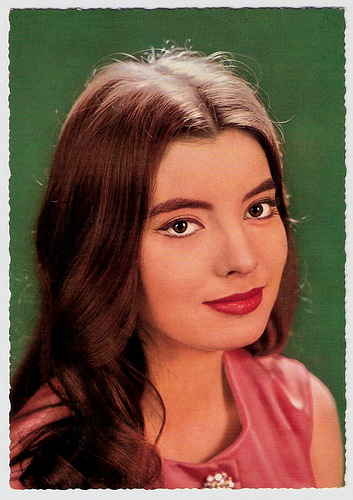
German postcard by Krüger, no. 902/112. Photo: Farabola.
Taking revenge on playboy Alain Delon
Jacqueline Sassard was born in Nice, France in 1940.
She started her career as a teenager in the French thriller Je plaide non coupable/Guilty? (Edmond Gréville, 1956).
The following year, she played the title role of the Italian comedy Guendalina (Alberto Lattuada, 1957), with Sylva Koscina and Raf Vallone as her parents.
The film was produced by Dino De Laurentiis and Carlo Ponti, and the latter offered her another lead role in the comedy Nata di marzo/Born in March (Antonio Pietrangeli, 1958) opposite Gabriele Ferzetti . For her role she won the Zuleta Prize at the San Sebastián International Film Festival 1958.
In Italy she also appeared as a young woman with family and economical troubles in Il magistrato/The Magistrate (Luigi Zampa, 1959), a co-production with Spain and France. The Spaniard José Suárez stars in the film, and other roles were played by François Périer and a 21-year-old Claudia Cardinale .
In the award-winning drama Estate violenta/Violent Summer (Valerio Zurlini, 1959), her character is left by Jean Louis Trintignant for Eleonora Rossi Drago .
She also played one of the three sisters who take revenge on playboy Alain Delon in the comedy Faibles femmes/Three Murderesses (Michel Boisrond, 1959), co-starring Mylène Démongeot and Pascale Petit .
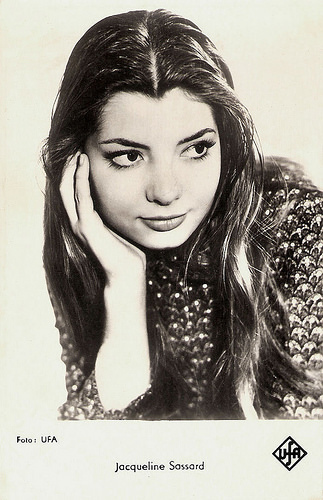
French postcard by Editions P.I., licency holder in France for Ufa, no. FK 4506. Photo: Ufa.
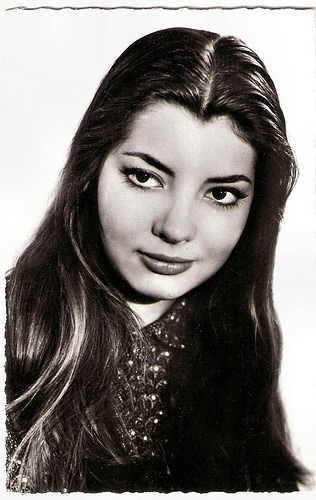
French postcard by Editions du Globe, Paris, no. 868. Photo: Studio Vauclair.
A heady mixture of Yiddish accents, Borscht-belt one-liners and rippling pecs
In the early 1960s, Jacqueline Sassard mainly worked in Italy in less prestigious films than before.
It was the period of the Peplum spectacles and she was seen as Antiope in Arrivano i titani/The Titans (Duccio Tessari, 1962) with Pedro Armendáriz and Giuliano Gemma .
Hal Erickson at AllMovie : “My Son the Hero started out in 1961 as a straightforward Italian sword and sandal affair titled Arrivano i Titani, all about the quest for a magic helmet in ancient Thebes. Well cast (Pedro Armendariz is the star) and extremely well photographed, the original film was still not sufficient different from all the other Italian strongman films glutting the American market in 1963. Thus the American distributors hit upon the notion of transforming the film into a satire, by redubbing all the actors and hoking up the sound effects. What resulted was a heady mixture of Yiddish accents, Borscht-belt one-liners and rippling pecs.”
Sassard also appeared in a small part opposite Steve Reeves in the adventure film Sandokan, la tigre di Mompracem/Sandokan the Great (Umberto Lenzi, 1963).
In between, Sassard played opposite Freddy Quinn in the German Schlagerfilm Freddy und das Lied der Südsee/Freddy and the Song of the South Seas (Werner Jacobs, 1962).
She had a supporting part in the Italian-French sex comedy Le voci bianche/Counter Tenors (Pasquale Festa Campanile, Massimo Franciosa, 1964) with Sandra Milo and Anouk Aimée .
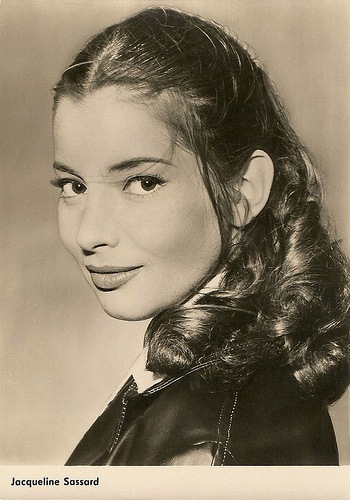
East-German postcard by VEB Progress Film-Verleih, Berlin. Collection: Didier Hanson.
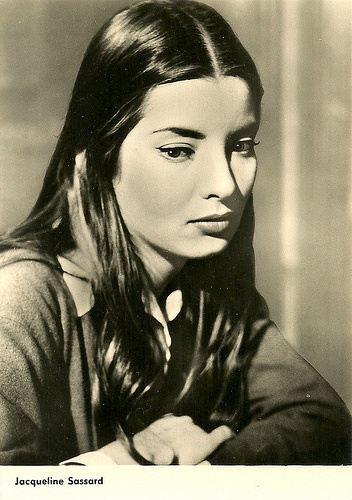
East-German postcard by VEB Progress Film-Verleih, Berlin. Photo: publicity still for Il Magistrato/The Magistrate (Luigi Zampa, 1959).
Captivating, sensual performances
One of Jacqueline Sassard’s best films is the Italian drama Le stagioni del nostro amore/Seasons of Our Love (Florestano Vancini, 1966) with Enrico Maria Salerno and Anouk Aimée .
Sassard then played an Austrian princess in the prestigious British film Accident (Joseph Losey, 1967), based on a script by Harold Pinter and starring Dirk Bogarde . At the 1967 Cannes Film Festival, the film won the Grand Prix Spécial du Jury.
Gavin Jones at IMDb : “One of the best films ever made, this movie oozes atmosphere. The cinematography is impeccable, the script disturbingly brilliant.”
Her last credited screen appearance was opposite Stéphane Audran and Jean-Louis Trintignant in the sensual and sexy thriller Les Biches/The Does/Girlfriends (1968), directed by Claude Chabrol. It was one of the first films subtly dealing with bisexuality.
James Travers at Films de France : “All the time, we, the audience, are seduced by the beautiful cinematography, the captivating, sensual performances, most notably from the Sphinx-like Stéphane Audran , and Chabrol's masterful direction. This is a deliciously seductive work, but one which is also profoundly disturbing.”
Then Jacqueline Sassard retired and disappeared from public view. In Brazil, she had met Gianni Lancia, the Italian former automobile engineer, industrialist and racing enthusiast. They married and have one son, Lorenzo.
Today, Jacqueline Sassard lives in Saint-Jean-Cap-Ferrat.
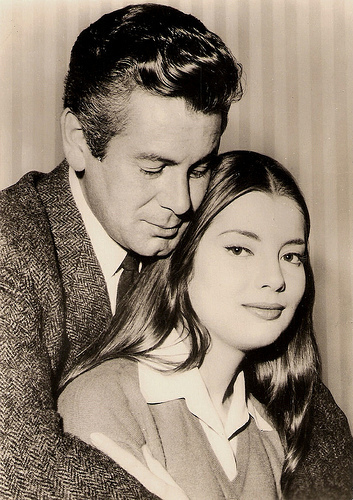
German postcard by VEB Progress Film-Verleih, Berlin, no. 1501, 1961. Photo: Jacqueline Sassard and José Suárez in Il magistrato/The Magistrate (Luigi Zampa, 1959), released in Germany as Der Richter.
Sources: Hal Erickson (AllMovie), James Travers (French Films), Gavin Jones (IMDb), Wikipedia and .

German postcard by Krüger, no. 902/112. Photo: Farabola.
Taking revenge on playboy Alain Delon
Jacqueline Sassard was born in Nice, France in 1940.
She started her career as a teenager in the French thriller Je plaide non coupable/Guilty? (Edmond Gréville, 1956).
The following year, she played the title role of the Italian comedy Guendalina (Alberto Lattuada, 1957), with Sylva Koscina and Raf Vallone as her parents.
The film was produced by Dino De Laurentiis and Carlo Ponti, and the latter offered her another lead role in the comedy Nata di marzo/Born in March (Antonio Pietrangeli, 1958) opposite Gabriele Ferzetti . For her role she won the Zuleta Prize at the San Sebastián International Film Festival 1958.
In Italy she also appeared as a young woman with family and economical troubles in Il magistrato/The Magistrate (Luigi Zampa, 1959), a co-production with Spain and France. The Spaniard José Suárez stars in the film, and other roles were played by François Périer and a 21-year-old Claudia Cardinale .
In the award-winning drama Estate violenta/Violent Summer (Valerio Zurlini, 1959), her character is left by Jean Louis Trintignant for Eleonora Rossi Drago .
She also played one of the three sisters who take revenge on playboy Alain Delon in the comedy Faibles femmes/Three Murderesses (Michel Boisrond, 1959), co-starring Mylène Démongeot and Pascale Petit .

French postcard by Editions P.I., licency holder in France for Ufa, no. FK 4506. Photo: Ufa.

French postcard by Editions du Globe, Paris, no. 868. Photo: Studio Vauclair.
A heady mixture of Yiddish accents, Borscht-belt one-liners and rippling pecs
In the early 1960s, Jacqueline Sassard mainly worked in Italy in less prestigious films than before.
It was the period of the Peplum spectacles and she was seen as Antiope in Arrivano i titani/The Titans (Duccio Tessari, 1962) with Pedro Armendáriz and Giuliano Gemma .
Hal Erickson at AllMovie : “My Son the Hero started out in 1961 as a straightforward Italian sword and sandal affair titled Arrivano i Titani, all about the quest for a magic helmet in ancient Thebes. Well cast (Pedro Armendariz is the star) and extremely well photographed, the original film was still not sufficient different from all the other Italian strongman films glutting the American market in 1963. Thus the American distributors hit upon the notion of transforming the film into a satire, by redubbing all the actors and hoking up the sound effects. What resulted was a heady mixture of Yiddish accents, Borscht-belt one-liners and rippling pecs.”
Sassard also appeared in a small part opposite Steve Reeves in the adventure film Sandokan, la tigre di Mompracem/Sandokan the Great (Umberto Lenzi, 1963).
In between, Sassard played opposite Freddy Quinn in the German Schlagerfilm Freddy und das Lied der Südsee/Freddy and the Song of the South Seas (Werner Jacobs, 1962).
She had a supporting part in the Italian-French sex comedy Le voci bianche/Counter Tenors (Pasquale Festa Campanile, Massimo Franciosa, 1964) with Sandra Milo and Anouk Aimée .

East-German postcard by VEB Progress Film-Verleih, Berlin. Collection: Didier Hanson.

East-German postcard by VEB Progress Film-Verleih, Berlin. Photo: publicity still for Il Magistrato/The Magistrate (Luigi Zampa, 1959).
Captivating, sensual performances
One of Jacqueline Sassard’s best films is the Italian drama Le stagioni del nostro amore/Seasons of Our Love (Florestano Vancini, 1966) with Enrico Maria Salerno and Anouk Aimée .
Sassard then played an Austrian princess in the prestigious British film Accident (Joseph Losey, 1967), based on a script by Harold Pinter and starring Dirk Bogarde . At the 1967 Cannes Film Festival, the film won the Grand Prix Spécial du Jury.
Gavin Jones at IMDb : “One of the best films ever made, this movie oozes atmosphere. The cinematography is impeccable, the script disturbingly brilliant.”
Her last credited screen appearance was opposite Stéphane Audran and Jean-Louis Trintignant in the sensual and sexy thriller Les Biches/The Does/Girlfriends (1968), directed by Claude Chabrol. It was one of the first films subtly dealing with bisexuality.
James Travers at Films de France : “All the time, we, the audience, are seduced by the beautiful cinematography, the captivating, sensual performances, most notably from the Sphinx-like Stéphane Audran , and Chabrol's masterful direction. This is a deliciously seductive work, but one which is also profoundly disturbing.”
Then Jacqueline Sassard retired and disappeared from public view. In Brazil, she had met Gianni Lancia, the Italian former automobile engineer, industrialist and racing enthusiast. They married and have one son, Lorenzo.
Today, Jacqueline Sassard lives in Saint-Jean-Cap-Ferrat.

German postcard by VEB Progress Film-Verleih, Berlin, no. 1501, 1961. Photo: Jacqueline Sassard and José Suárez in Il magistrato/The Magistrate (Luigi Zampa, 1959), released in Germany as Der Richter.
Sources: Hal Erickson (AllMovie), James Travers (French Films), Gavin Jones (IMDb), Wikipedia and .
Published on October 07, 2014 23:00
October 6, 2014
Enrico Macias
French Pied Noir singer Enrico Macias (1938) is one of the pioneers of mixed music. From the early 1960s to the present, he toured extensively through the world and always sought to convey his ideas of peace and solidarity during his travels. The popular musician also worked as an actor and appeared in some films.
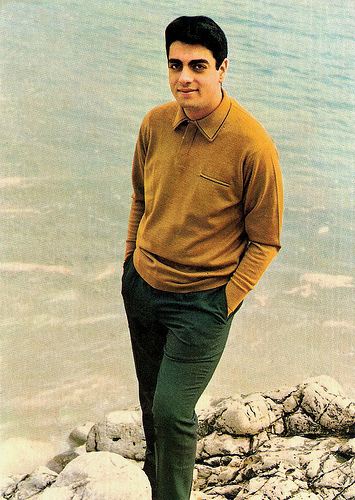
French postcard by Edition Borde, Paris, no. 123. Photo: Neuvecelle.
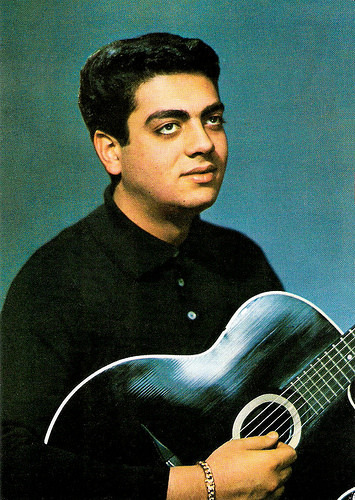
French postcard by E.D.U.G., no. 438. Photo: Sam Lévin.
Black Feet
Enrico Macias was born as Gaston Ghrenassia in 1938 to an Algerian Jewish family in Constantine, Algeria (then French Algeria). His father, Sylvain Ghrenassia, was a violinist in the prestigious Cheikh Raymond Leyris Orchestra that played primarily Maalouf, the Arab-Andalusian music unique to Constantine.
From his childhood on, Gaston played the guitar and at the age of 15, he joined the Cheikh Raymond Leyris Orchestra. Later, he worked as a primary schoolmaster, but continued practicing the guitar.
In 1961, the War of Independence was raging in Algeria, which had been a French colony since the nineteenth century. The situation became untenable for the Jewish and European residents of Constantine. On 22 June 1961, Cheick Raymond Leyris, who just had become father-in-law of Gaston, was killed in Constantine. Gaston and his wife Suzy Leyris left Algeria in July 1961, eleven months before the end of the Algerian War of Independence.
They went into exile in France, and Gaston has not been permitted to return to Algeria ever since. First living in Argenteuil, he eventually moved to Paris, where he decided to pursue a career in music. At first he tried translating into French the Maalouf numbers which he already knew. Later on, he developed a new French repertoire that he performed in cafés and cabarets.
He remained, though, a popular interpreter of Arab-Andalusian music and Judeo-Arab songs in France.
He adopted the name Enrico Macias. Enrico comes from him being called ‘petit Enrico’ when he joined Cheikh Raymond's orchestra. Macias comes through an error of the record label with which he eventually signed. When asked about his family name on the phone he said ‘Nassia’ (Ghrenassia), but the receptionist misheard the name and wrote Macias. Thus the name Enrico Macias.
He made his first recording in 1962 after a meeting with Raymond Bernard of Pathé. The result was the recording of Adieu mon pays which he had composed for his beloved Algeria on the boat on his way to France. He appeared on French television in a program about the French citizens repatriated from Algeria, the Pieds Noirs (‘black feet’ - because they wore black shoes).
Enrico became an overnight sensation. This led to a first tour in 1963 as a second act with Paola and Billy Bridge. His daughter, Jocya, was also born that year. In spring 1964, he performed in the first half of the Les Compagnons de la chanson show at the Paris Olympia and then undertook a successful tour of the Middle East, performing with great success in Israel, Greece and Turkey, especially in the latter where he still has a huge following today. In Turkey, many of his songs were translated and interpreted by Turkish artists.
He also started to appear in films, such as in Déclic et des claques/Clicks and slaps (Philippe Clair, 1965) starring Annie Girardot . In 1965, he was awarded the Prix Vincent Scotto, and the following year he sang before 120,000 people at the Dinamo Stadium in Moscow, performing concerts in more than 40 other Soviet cities. He also toured Japan, where he was impressively successful. He recorded titles in Spanish and Italian and was popular in both countries.
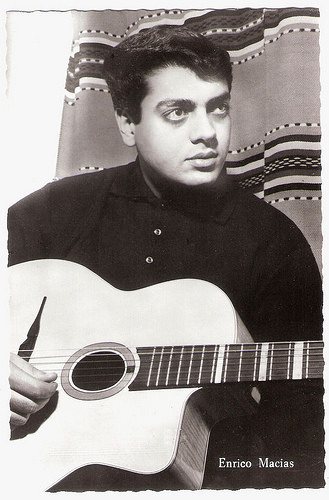
Dutch postcard.
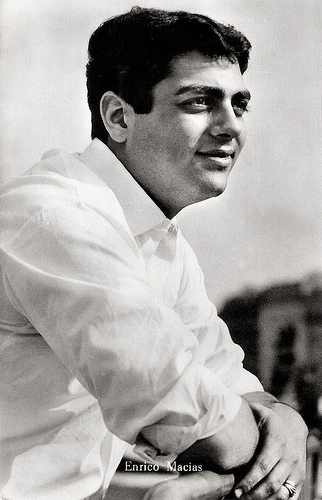
Dutch postcard by Gebr. Spanjersberg N.V. (Sparo), Rotterdam, no. 1263. Photo: Pathé.
Singer of Peace
In 1968, Enrico Macias had a huge success in New York at a sold-out Carnegie Hall. He continued to tour the US, singing in Chicago, Dallas and Los Angeles. In Canada and Quebec, he was warmly welcomed as a francophone artist. In 1971, he returned to the Paris Olympia, then went to the Royal Albert Hall in London, and back to Japan, Canada, Italy and Spain. A second US tour culminated in another concert at Carnegie Hall in 1972.
In 1974, he gave ten shows at the Uris Theater on Broadway, and also at the Olympia for the sixth time since his debut. He toured France and went twice to Israel in 1976 and 1978. In 1976, he received a gold disc for his album Mélisa.
In 1978, Macias was invited to Egypt by President Anwar El Sadat to sing for peace. This came after Macias having been banned from Arab countries for many years, despite keeping his popularity with Arab and ethnic audiences in the Middle East and North Africa. In Egypt, he sang in front of 20,000 people at the foot of the Pyramids. He was named Singer of Peace by UN Secretary-General Kurt Waldheim in 1981 after he donated the royalties of his single Malheur à celui qui blesse un enfant to Unicef. After Sadat's assassination in 1981, Macias wrote the song Un berger vient de tomber, dedicated to the late president. In 1997, Kofi Annan named him Roving Ambassador for Peace and the Defence of Children.
In September 1982, after another tour of the United States, he performed for a month at the Olympia with his father Sylvain's oriental orchestra. Enrico Macias was awarded the Légion d'honneur, by French Prime Minister Laurent Fabius three years later. He had a big hit with Zingarella (1988), particularly in Israel and Turkey upon his tour in both countries in addition to South Korea.
His decision to try to play concerts in Algeria resulted in huge controversy. After the cancellation of a proposed tour in Algeria in 2000, he wrote a book Mon Algérie (2001) marketed as a ‘veritable love story between one man and his homeland’.
He took up acting and played parts in the film comedies La vérité si je mens! 2/Would I Lie to You? 2 (Thomas Gilou, 2001) and Les clefs de bagnole (Laurent Baffie, 2003). He also played the lead role as a local judge in the French TV film Monsieur Molina (Thierry Binisti, 2005) opposite Jean-Claude Drouot .
In 2007, he created more controversy when he announced his support of Nicolas Sarkozy for the French presidential elections. He confirmed his political convictions of the political left, but said he could not support the Socialist candidate Ségolène Royal. That year, he attempted again unsuccessfully to visit Algeria accompanying Sarkozy. He was faced with fierce resistance from several Algerian organizations and individuals, including Algerian Prime Minister Abdelaziz Belkhadem, due to his support of Israel.
A year later, his wife Suzy Leyris died after a long illness. Their son, Jean-Claude Ghrenassia, is a well-known music producer who produced his father’s album Oranges Amères (2003) and La Vie populaire (2006).
In 2009, Macias went through a difficult period when he lost several million euro placed in an Icelandic bank that went bankrupt. He came out of semi-retirement with amazing energy and the new album Voyage d’une mélodie, bursting with joyful songs. And as in the past, the now 70+ singer went on a world tour.
He also played again in several film comedies, including Bienvenue à bord (Eric Lavaine, 2011) starring Franck Dubosc, and La vérité si je mens! 3/Would I Lie to You? 3 (Thomas Gilou, 2012).
In 2013, Gaston Ghrenassia legally changed his name to Enrique Macias.
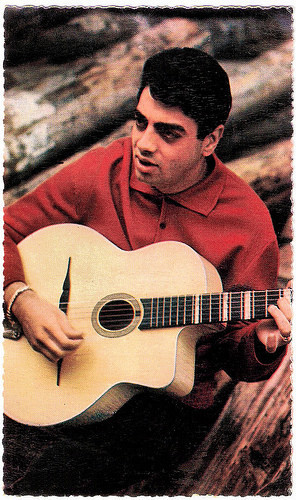
French postcard by Publistar, Marseille, no. 1107, offered by Corvisart. Photo: Gérard Neuvecelle / Pathé.
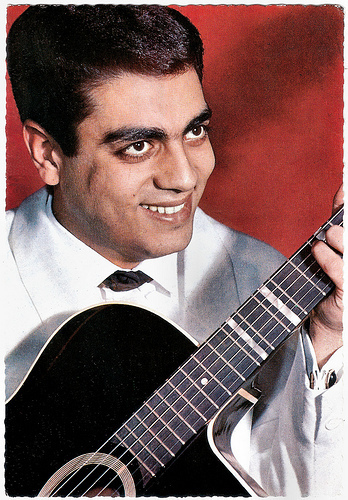
French postcard by PSG, no. 916. Photo: Mainbourg / Pathé.
Sources: RFI Musique (French), Wikipedia and .

French postcard by Edition Borde, Paris, no. 123. Photo: Neuvecelle.

French postcard by E.D.U.G., no. 438. Photo: Sam Lévin.
Black Feet
Enrico Macias was born as Gaston Ghrenassia in 1938 to an Algerian Jewish family in Constantine, Algeria (then French Algeria). His father, Sylvain Ghrenassia, was a violinist in the prestigious Cheikh Raymond Leyris Orchestra that played primarily Maalouf, the Arab-Andalusian music unique to Constantine.
From his childhood on, Gaston played the guitar and at the age of 15, he joined the Cheikh Raymond Leyris Orchestra. Later, he worked as a primary schoolmaster, but continued practicing the guitar.
In 1961, the War of Independence was raging in Algeria, which had been a French colony since the nineteenth century. The situation became untenable for the Jewish and European residents of Constantine. On 22 June 1961, Cheick Raymond Leyris, who just had become father-in-law of Gaston, was killed in Constantine. Gaston and his wife Suzy Leyris left Algeria in July 1961, eleven months before the end of the Algerian War of Independence.
They went into exile in France, and Gaston has not been permitted to return to Algeria ever since. First living in Argenteuil, he eventually moved to Paris, where he decided to pursue a career in music. At first he tried translating into French the Maalouf numbers which he already knew. Later on, he developed a new French repertoire that he performed in cafés and cabarets.
He remained, though, a popular interpreter of Arab-Andalusian music and Judeo-Arab songs in France.
He adopted the name Enrico Macias. Enrico comes from him being called ‘petit Enrico’ when he joined Cheikh Raymond's orchestra. Macias comes through an error of the record label with which he eventually signed. When asked about his family name on the phone he said ‘Nassia’ (Ghrenassia), but the receptionist misheard the name and wrote Macias. Thus the name Enrico Macias.
He made his first recording in 1962 after a meeting with Raymond Bernard of Pathé. The result was the recording of Adieu mon pays which he had composed for his beloved Algeria on the boat on his way to France. He appeared on French television in a program about the French citizens repatriated from Algeria, the Pieds Noirs (‘black feet’ - because they wore black shoes).
Enrico became an overnight sensation. This led to a first tour in 1963 as a second act with Paola and Billy Bridge. His daughter, Jocya, was also born that year. In spring 1964, he performed in the first half of the Les Compagnons de la chanson show at the Paris Olympia and then undertook a successful tour of the Middle East, performing with great success in Israel, Greece and Turkey, especially in the latter where he still has a huge following today. In Turkey, many of his songs were translated and interpreted by Turkish artists.
He also started to appear in films, such as in Déclic et des claques/Clicks and slaps (Philippe Clair, 1965) starring Annie Girardot . In 1965, he was awarded the Prix Vincent Scotto, and the following year he sang before 120,000 people at the Dinamo Stadium in Moscow, performing concerts in more than 40 other Soviet cities. He also toured Japan, where he was impressively successful. He recorded titles in Spanish and Italian and was popular in both countries.

Dutch postcard.

Dutch postcard by Gebr. Spanjersberg N.V. (Sparo), Rotterdam, no. 1263. Photo: Pathé.
Singer of Peace
In 1968, Enrico Macias had a huge success in New York at a sold-out Carnegie Hall. He continued to tour the US, singing in Chicago, Dallas and Los Angeles. In Canada and Quebec, he was warmly welcomed as a francophone artist. In 1971, he returned to the Paris Olympia, then went to the Royal Albert Hall in London, and back to Japan, Canada, Italy and Spain. A second US tour culminated in another concert at Carnegie Hall in 1972.
In 1974, he gave ten shows at the Uris Theater on Broadway, and also at the Olympia for the sixth time since his debut. He toured France and went twice to Israel in 1976 and 1978. In 1976, he received a gold disc for his album Mélisa.
In 1978, Macias was invited to Egypt by President Anwar El Sadat to sing for peace. This came after Macias having been banned from Arab countries for many years, despite keeping his popularity with Arab and ethnic audiences in the Middle East and North Africa. In Egypt, he sang in front of 20,000 people at the foot of the Pyramids. He was named Singer of Peace by UN Secretary-General Kurt Waldheim in 1981 after he donated the royalties of his single Malheur à celui qui blesse un enfant to Unicef. After Sadat's assassination in 1981, Macias wrote the song Un berger vient de tomber, dedicated to the late president. In 1997, Kofi Annan named him Roving Ambassador for Peace and the Defence of Children.
In September 1982, after another tour of the United States, he performed for a month at the Olympia with his father Sylvain's oriental orchestra. Enrico Macias was awarded the Légion d'honneur, by French Prime Minister Laurent Fabius three years later. He had a big hit with Zingarella (1988), particularly in Israel and Turkey upon his tour in both countries in addition to South Korea.
His decision to try to play concerts in Algeria resulted in huge controversy. After the cancellation of a proposed tour in Algeria in 2000, he wrote a book Mon Algérie (2001) marketed as a ‘veritable love story between one man and his homeland’.
He took up acting and played parts in the film comedies La vérité si je mens! 2/Would I Lie to You? 2 (Thomas Gilou, 2001) and Les clefs de bagnole (Laurent Baffie, 2003). He also played the lead role as a local judge in the French TV film Monsieur Molina (Thierry Binisti, 2005) opposite Jean-Claude Drouot .
In 2007, he created more controversy when he announced his support of Nicolas Sarkozy for the French presidential elections. He confirmed his political convictions of the political left, but said he could not support the Socialist candidate Ségolène Royal. That year, he attempted again unsuccessfully to visit Algeria accompanying Sarkozy. He was faced with fierce resistance from several Algerian organizations and individuals, including Algerian Prime Minister Abdelaziz Belkhadem, due to his support of Israel.
A year later, his wife Suzy Leyris died after a long illness. Their son, Jean-Claude Ghrenassia, is a well-known music producer who produced his father’s album Oranges Amères (2003) and La Vie populaire (2006).
In 2009, Macias went through a difficult period when he lost several million euro placed in an Icelandic bank that went bankrupt. He came out of semi-retirement with amazing energy and the new album Voyage d’une mélodie, bursting with joyful songs. And as in the past, the now 70+ singer went on a world tour.
He also played again in several film comedies, including Bienvenue à bord (Eric Lavaine, 2011) starring Franck Dubosc, and La vérité si je mens! 3/Would I Lie to You? 3 (Thomas Gilou, 2012).
In 2013, Gaston Ghrenassia legally changed his name to Enrique Macias.

French postcard by Publistar, Marseille, no. 1107, offered by Corvisart. Photo: Gérard Neuvecelle / Pathé.

French postcard by PSG, no. 916. Photo: Mainbourg / Pathé.
Sources: RFI Musique (French), Wikipedia and .
Published on October 06, 2014 23:00
October 5, 2014
Luciano Albertini
Muscular Italian actor Luciano Albertini (1882-1945) was one of the most famous strongmen and daredevils of the silent cinema. The former circus artist first worked as an actor and producer for the Italian cinema and later moved to Berlin, where his Latin appeal made many admirers swoon. He also filmed in America as well as in the Soviet Union.
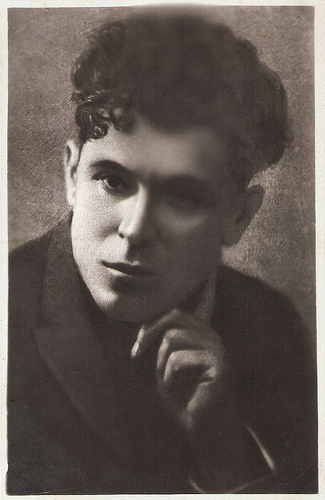
American postcard by A.G.F. Photo: Photocine.
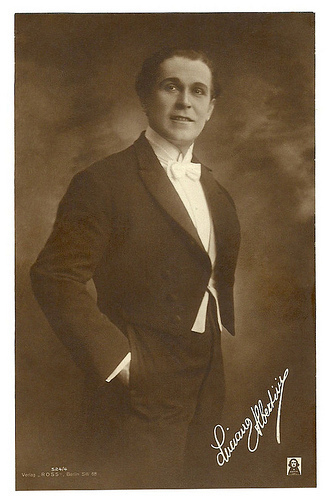
German postcard by Ross Verlag, Berlin, no. 524/4, 1919-1924. Collection: Didier Hanson.
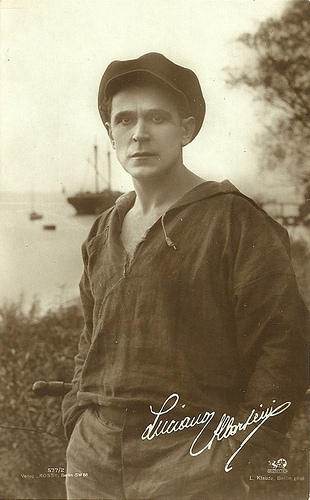
German postcard by Ross Verlag, no. 577/2. Photo L. Klaude, Berlin /Phoebus Film. Albertini did very few films at Phoebus, so this might be Die Heimkehr des Odysseus/The Homecoming of Odysseuss (Max Obal, 1922), provided it was a modern adaptation of the story.
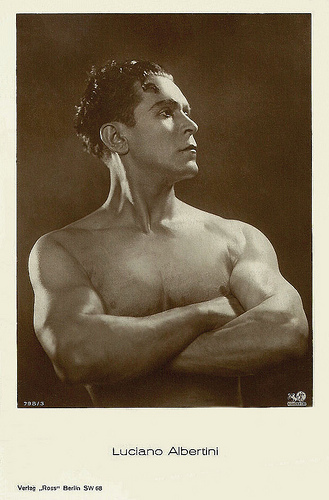
German postcard by Ross Verlag, no. 798/3, 1925-1926. Photo: Phoebus Film, Berlin.
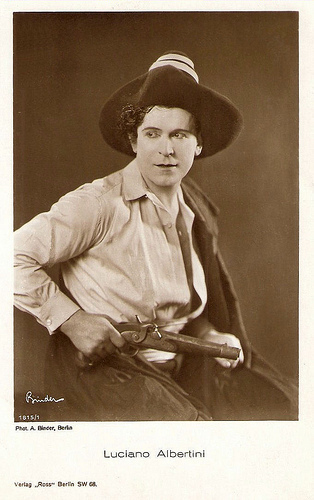
German postcard by Ross Verlag, Berlin, no. 1815/1, 1927-1928. Photo: A. (Alex) Binder, Berlin.
Flying Trapeze
Luciano Albertini was born as Francesco Vespignani in Lugo di Romagna, Italy, in 1882.
In his youth, he already showed a passion for sports, joining the gymnastics club in Forlí and later in Bologna. After his studies he ended up in France, where he retook his lessons in physical exercise at the Ecole Péchin in Lyon.
He entered the Circus Busch and in 1905 he married circus artist Domenica Meirone in Marseille. He took the stage name of Luciano Albertini and created a number on the flying trapeze with 8 persons: Les Albertini. His speciality was a stunt, the ‘death spiral’.
When he returned to Italy, he started his film career in historical epics as Spartaco/Spartacus (Giovanni Enrico Vidali, 1913). At IMDb , Michael Elliott reviews: "The second adaptation of Raffaello Giovagnoli's novel comes at a time when Italy really started pumping out their epic films with the longer running times, expensive sets and lavish production values. This film really doesn't stray too far from the source as we have our hero Spartacus being sold as a slave only to rise up and battle the evil Crassus. These Italian movies are certainly a far cry from the American ones coming out at the same time and this one here has so much going for it that I'm sure even the most jaded silent-hater would have to respect what's on display here."
Albertini also appeared opposite film diva Francesca Bertina in Assunta Spina (Francesca Bertini, Gustavo Serena, 1915).
The First World War broke out and Albertini joined the navy. He still kept one foot to the ground though, and he worked at the film company Società Anonima Ambrosio of Turin.
His breakthrough was the circus film La spirale della morte/The Death Spiral (Filippo Castamagna, Domenico Gambino, 1917).
Afterwards he worked for the studios Pasquali and Latina Ars, both also in Turin. At Pasquali he started the successful Sansone (Samson) series, with Sansone contro i Filistei/Sansone Against the Philistines (Domenico Gaido, 1918).
Luciano Albertini's finest moment came when he founded his own company Albertini Film, that released its first films in 1919.
Until 1921 Albertini Film produced three series: the Sansone films, the Lilliput series with the children Arnold (Patata) and Varada (they were not Albertini’s children although the promotion pretended so), and the series Sansonette with Linda Albertini , his so-called wife, but her true identity remains a mystery.
Albertini also produced Il mostro di Frankenstein/The Monster of Frankenstein (Eugenio Testa, 1920), in which he himself personified Baron Frankenstein.
His best film was not one of his Sansone films but the costume drama Il Ponte dei Sospiri/The Bridge of Sighs (Domenico Gaido, 1921), a swashbuckler set in Venice.
Albertini played Rolando Candiani, son of the Doge of Venice, who is falsely accused of murder by his enemies. One plots to become Doge himself, another wants to steal the beautiful Leonora, Rolando's fiancée, a third is a courtesan rejected by Rolando.
On the day of his marriage Rolando is arrested, trialled and passes the Bridge of Sighs before entering lifetime imprisonment. His father is dethroned as Doge, blinded and reduced to a wandering beggar. But with the help of the courageous and good-hearted bandit Scalabrino (Garaveo Onorato), Rolando manages to escape and take revenge...
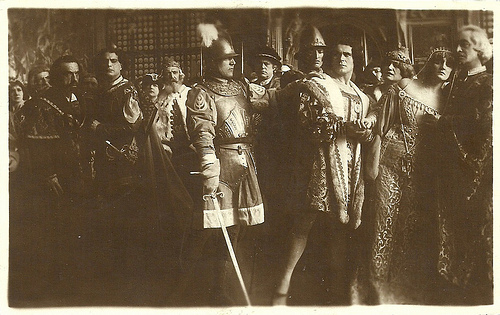
Italian postcard by Unione Cinematografica Italiana. Luciano Albertini as Rolando in the four part serial film Il ponte dei sospiri/The Bridge of Sighs (Domenico Gaido, 1921). On his right side Carolina White (Leonora) and Bonaventura Ibanez (her father Dandolo).
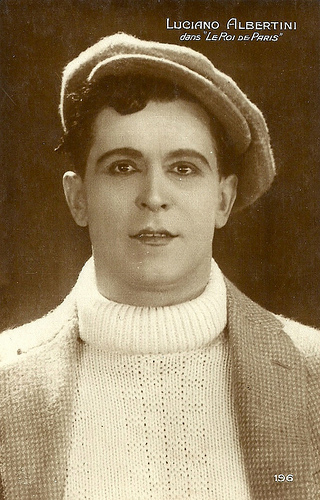
French postcard by Editions Cinémagazine, no. 196. Photo: Luciano Albertini in Julot, der Apache/Julot, the Apache (Joseph Delmont, Hertha von Walther, 1921), released in France as Julot l'apache but also Le roi de Paris.
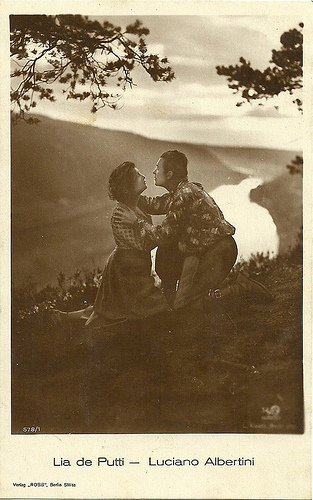
German postcard by Ross Verlag, no. 578/1, 1919-1924. Photo: Leo Klaude, Berlin / Phoebus Film. Publicity still for Die Schlucht des Todes/The Ravine of Death (Luciano Albertini, Albert-Francis Bertoni, Max Obal, 1923) with Lya de Putti .
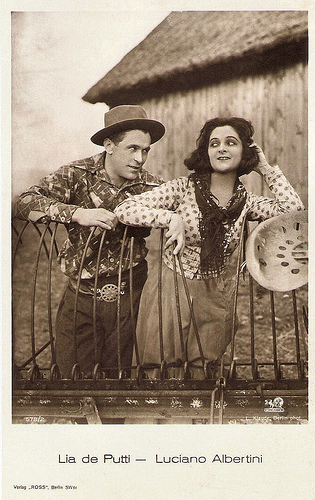
German postcard by Ross Verlag, no. 578/2, 1919-1924. Photo: Leo Klaude, Berlin / Phoebus Film. Publicity still for Die Schlucht des Todes/The Ravine of Death (Luciano Albertini, Albert-Francis Bertoni, Max Obal, 1923) with Lya de Putti .
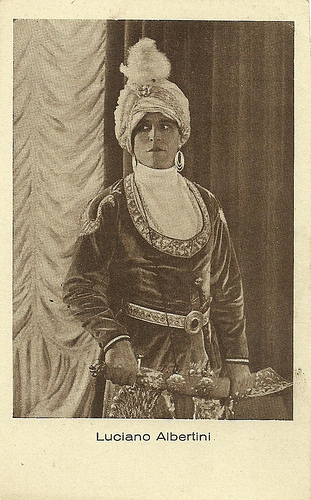
German postcard. Photo: Luciano Albertini in Der Sieg des Maharadscha/The victory of the Maharajah (Joseph Delmont, 1923).
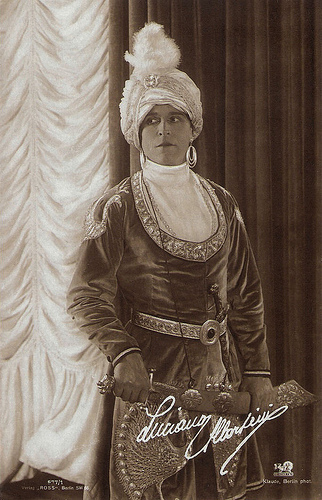
German postcard by Ross Verlag, no. 577/1, 1919-1924. Photo: Klaude, Berlin / Phoebus-Film. Publicity still for Der Sieg des Maharadscha/The victory of the Maharajah (Joseph Delmont, 1923).
Berlin Entourage
The crisis in the Italian cinema forced Albertini Film to move to Germany where Luciano Albertini was well received.
Linda, though, returned after one year and four films, because Luciano had an affair with another woman.
In the 1920s, he was very popular in German films directed by Joseph Delmont, Nunzio Malasomma – another Italian immigrant working in Berlin - and Max Obal.
Albertini also directed and produced himself once in Die Schlucht des Todes/The Ravine of Death (Luciano Albertini, Albert-Francis Bertoni, Max Obal, 1923) opposite vamp Lya de Putti .
He started in Germany with a series of films directed by Delmont and produced by himself: Der König der Manege/The King of the Circus Ring (1921), Der eiserne Faust/The Iron Fist (1921), Julot der Apache/Julot the Apache (1921), Der Todesleiter/The Death Ladder (1921), and Der Man aus Stahl/The Steel Man (1922).
With Malasomma, Albertini did Mister Radio (1924), Der König und die kleine Mädchen/The King and the Little Girls (1925), and Eine Minute vor 12/One Minute to Twelve (1925).
Obal directed the most of the Albertini films: Die heimkehr des Odysseus/The Return of Odysseus (1922), Rinaldo Rinaldini (1927) starring opposite Hans Albers , Der grösste Gauner des Jahrhunderts/The Biggest Crook of the Century (1927), Der Unüberwindliche/The Invincible (1928) with Vivian Gibson , Tempo! Tempo! (1929) with Hilda Rosch , and Jagd nach der Million/The Hunt for a Million (1930) with Gretl Berndt.
Albertini also appeared in the Soviet classic Arsenal/January Uprising in Kiev (Aleksandr Dovzhenko, 1928).
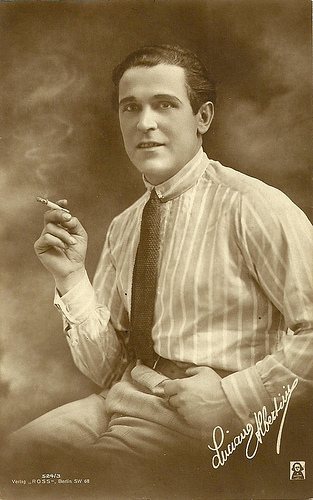
German postcard by Ross Verlag, Berlin SW, no. 524/3.
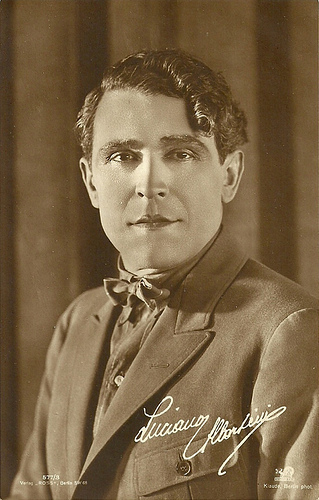
German postcard by Ross Verlag, Berlin, no. 577/8. Photo Krause, Berlin / Phoebus Film.
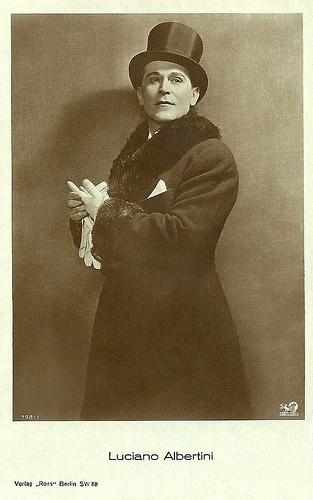
German postcard by Ross Verlag, Berlin, no. 798/1, 1925-1926. Collection: Didier Hanson.
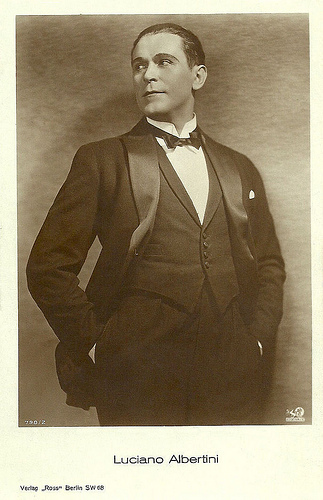
German postcard by Ross Verlag, Berlin, no. 798/2, 1925-1926. Photo: Phoebus Film, Berlin. Collection: Didier Hanson.
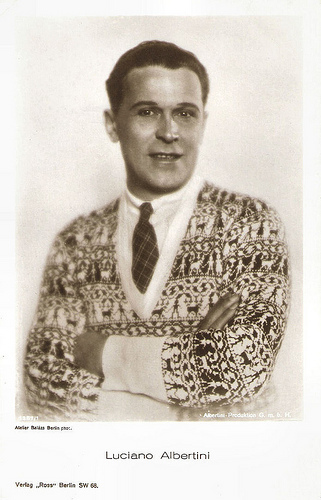
German postcard by Ross Verlag, no. 1287/1, 1927-1928. Photo: Atelier Balazs, Berlin / Albertini-Produktion GmbH.
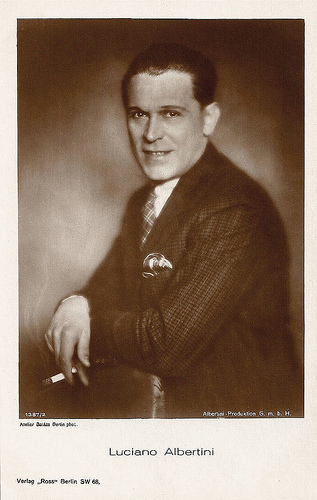
German postcard by Ross Verlag, no. 1387/2, 1927-1928. Photo: Atelier Balazs, Berlin / Albertini Produktion GmbH.
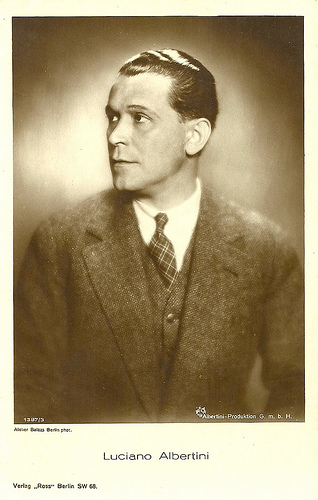
German postcard by Ross Verlag, no. 1387/3, 1927-1928. Photo: Atelier Balazs, Berlin / Albertini Produktion GmbH.
Asylum
In Berlin, Luciano Albertini lived in grand style, visiting restaurants with his friends and crew. He lived in a villa in the outskirts, in the workman’s quarter Siemensstadt.
Albertini had several affairs in Berlin, including one with actress Annie Gorilowa. At the Sportpalast, he and Marlene Dietrich were the big attractions.
His only setback had been his collaboration with Universal Studios to the American 15 part-serial The Iron Man (Jay Marchant, 1924), as he proved not to be the protagonist. Instead he had been forced to jump from the Brooklyn Bridge to a raceboat, while he often had his stuntmen doing this.
In 1930, the tide changed for Albertini. The talkies, his age (he was 50 now), the saturation of the acrobatic genre contributed, but his alcoholism really finished him.
Although Angelo Rossi, his double, and Lamberti, his ex-cameraman who had opened a restaurant in the Friedrichstrasse, helped him, Albertini went down all the way.
He performed in one last film: Es geht um alle/It Involves Everything (Max Nosseck, 1932) with Ernö Verebes.
When he showed aggression against a doorman he was put in an asylum and was diagnosed with dementia. In the late 1930s he returned to Italy, living in Bologna where a Father Marella took care of him.
His disease lead him to Villa Flora in Bologna and finally to the mental asylum San Gaetano in Budrio near Bologna. Luciano Albertini died here, in 1945.
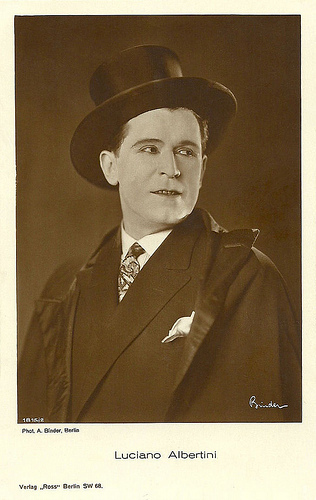
German postcard by Ross Verlag, Berlin, no. 1816/2, 1927-1928. Photo: Alex Binder. Collection: Didier Hanson.
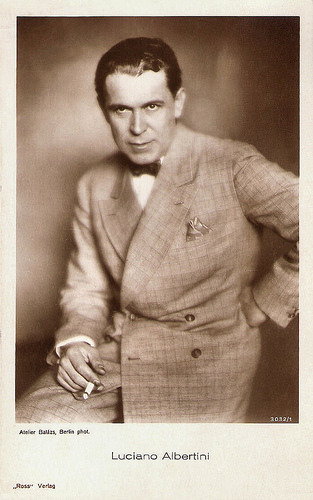
German postcard by Ross Verlag, no. 3032/1, 1928-1929. Photo: Atelier Balázs, Berlin.
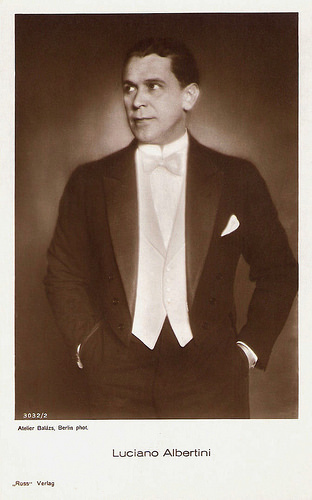
German postcard by Ross Verlag, no. 3032/2, 1928-1929. Photo: Atelier Balázs, Berlin.
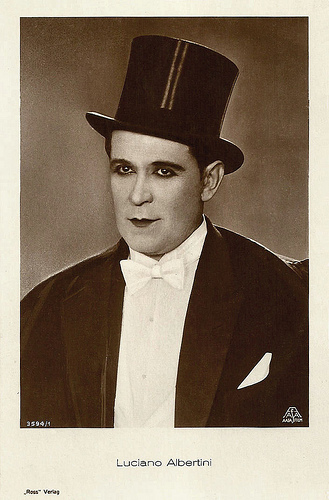
German postcard by Ross Verlag, no. 3594/1, 1928-1929. Photo: Aafa Film.
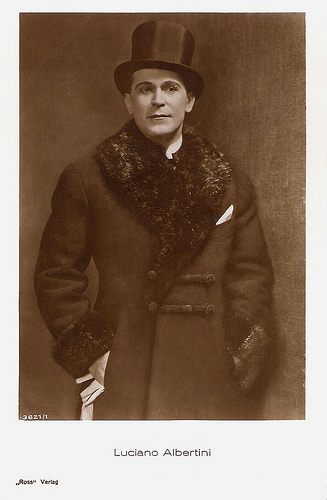
German postcard by Ross Verlag, no. 3621/1, 1928-1929.
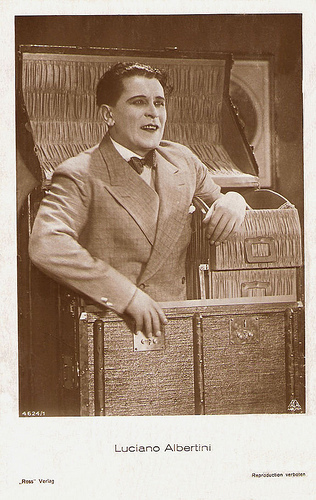
German postcard by Ross Verlag, no. 4624/1, 1929-1930. Photo: Aafa-Film.
Sources: Vittorio Martinelli/Mario Quargnolo (Maciste & Co. I giganti buoni del muto italiano), Thomas Staedeli (Cyranos), Michael Elliott (IMDb), (IMDb), Wikipedia (German) and .

American postcard by A.G.F. Photo: Photocine.

German postcard by Ross Verlag, Berlin, no. 524/4, 1919-1924. Collection: Didier Hanson.

German postcard by Ross Verlag, no. 577/2. Photo L. Klaude, Berlin /Phoebus Film. Albertini did very few films at Phoebus, so this might be Die Heimkehr des Odysseus/The Homecoming of Odysseuss (Max Obal, 1922), provided it was a modern adaptation of the story.

German postcard by Ross Verlag, no. 798/3, 1925-1926. Photo: Phoebus Film, Berlin.

German postcard by Ross Verlag, Berlin, no. 1815/1, 1927-1928. Photo: A. (Alex) Binder, Berlin.
Flying Trapeze
Luciano Albertini was born as Francesco Vespignani in Lugo di Romagna, Italy, in 1882.
In his youth, he already showed a passion for sports, joining the gymnastics club in Forlí and later in Bologna. After his studies he ended up in France, where he retook his lessons in physical exercise at the Ecole Péchin in Lyon.
He entered the Circus Busch and in 1905 he married circus artist Domenica Meirone in Marseille. He took the stage name of Luciano Albertini and created a number on the flying trapeze with 8 persons: Les Albertini. His speciality was a stunt, the ‘death spiral’.
When he returned to Italy, he started his film career in historical epics as Spartaco/Spartacus (Giovanni Enrico Vidali, 1913). At IMDb , Michael Elliott reviews: "The second adaptation of Raffaello Giovagnoli's novel comes at a time when Italy really started pumping out their epic films with the longer running times, expensive sets and lavish production values. This film really doesn't stray too far from the source as we have our hero Spartacus being sold as a slave only to rise up and battle the evil Crassus. These Italian movies are certainly a far cry from the American ones coming out at the same time and this one here has so much going for it that I'm sure even the most jaded silent-hater would have to respect what's on display here."
Albertini also appeared opposite film diva Francesca Bertina in Assunta Spina (Francesca Bertini, Gustavo Serena, 1915).
The First World War broke out and Albertini joined the navy. He still kept one foot to the ground though, and he worked at the film company Società Anonima Ambrosio of Turin.
His breakthrough was the circus film La spirale della morte/The Death Spiral (Filippo Castamagna, Domenico Gambino, 1917).
Afterwards he worked for the studios Pasquali and Latina Ars, both also in Turin. At Pasquali he started the successful Sansone (Samson) series, with Sansone contro i Filistei/Sansone Against the Philistines (Domenico Gaido, 1918).
Luciano Albertini's finest moment came when he founded his own company Albertini Film, that released its first films in 1919.
Until 1921 Albertini Film produced three series: the Sansone films, the Lilliput series with the children Arnold (Patata) and Varada (they were not Albertini’s children although the promotion pretended so), and the series Sansonette with Linda Albertini , his so-called wife, but her true identity remains a mystery.
Albertini also produced Il mostro di Frankenstein/The Monster of Frankenstein (Eugenio Testa, 1920), in which he himself personified Baron Frankenstein.
His best film was not one of his Sansone films but the costume drama Il Ponte dei Sospiri/The Bridge of Sighs (Domenico Gaido, 1921), a swashbuckler set in Venice.
Albertini played Rolando Candiani, son of the Doge of Venice, who is falsely accused of murder by his enemies. One plots to become Doge himself, another wants to steal the beautiful Leonora, Rolando's fiancée, a third is a courtesan rejected by Rolando.
On the day of his marriage Rolando is arrested, trialled and passes the Bridge of Sighs before entering lifetime imprisonment. His father is dethroned as Doge, blinded and reduced to a wandering beggar. But with the help of the courageous and good-hearted bandit Scalabrino (Garaveo Onorato), Rolando manages to escape and take revenge...

Italian postcard by Unione Cinematografica Italiana. Luciano Albertini as Rolando in the four part serial film Il ponte dei sospiri/The Bridge of Sighs (Domenico Gaido, 1921). On his right side Carolina White (Leonora) and Bonaventura Ibanez (her father Dandolo).

French postcard by Editions Cinémagazine, no. 196. Photo: Luciano Albertini in Julot, der Apache/Julot, the Apache (Joseph Delmont, Hertha von Walther, 1921), released in France as Julot l'apache but also Le roi de Paris.

German postcard by Ross Verlag, no. 578/1, 1919-1924. Photo: Leo Klaude, Berlin / Phoebus Film. Publicity still for Die Schlucht des Todes/The Ravine of Death (Luciano Albertini, Albert-Francis Bertoni, Max Obal, 1923) with Lya de Putti .

German postcard by Ross Verlag, no. 578/2, 1919-1924. Photo: Leo Klaude, Berlin / Phoebus Film. Publicity still for Die Schlucht des Todes/The Ravine of Death (Luciano Albertini, Albert-Francis Bertoni, Max Obal, 1923) with Lya de Putti .

German postcard. Photo: Luciano Albertini in Der Sieg des Maharadscha/The victory of the Maharajah (Joseph Delmont, 1923).

German postcard by Ross Verlag, no. 577/1, 1919-1924. Photo: Klaude, Berlin / Phoebus-Film. Publicity still for Der Sieg des Maharadscha/The victory of the Maharajah (Joseph Delmont, 1923).
Berlin Entourage
The crisis in the Italian cinema forced Albertini Film to move to Germany where Luciano Albertini was well received.
Linda, though, returned after one year and four films, because Luciano had an affair with another woman.
In the 1920s, he was very popular in German films directed by Joseph Delmont, Nunzio Malasomma – another Italian immigrant working in Berlin - and Max Obal.
Albertini also directed and produced himself once in Die Schlucht des Todes/The Ravine of Death (Luciano Albertini, Albert-Francis Bertoni, Max Obal, 1923) opposite vamp Lya de Putti .
He started in Germany with a series of films directed by Delmont and produced by himself: Der König der Manege/The King of the Circus Ring (1921), Der eiserne Faust/The Iron Fist (1921), Julot der Apache/Julot the Apache (1921), Der Todesleiter/The Death Ladder (1921), and Der Man aus Stahl/The Steel Man (1922).
With Malasomma, Albertini did Mister Radio (1924), Der König und die kleine Mädchen/The King and the Little Girls (1925), and Eine Minute vor 12/One Minute to Twelve (1925).
Obal directed the most of the Albertini films: Die heimkehr des Odysseus/The Return of Odysseus (1922), Rinaldo Rinaldini (1927) starring opposite Hans Albers , Der grösste Gauner des Jahrhunderts/The Biggest Crook of the Century (1927), Der Unüberwindliche/The Invincible (1928) with Vivian Gibson , Tempo! Tempo! (1929) with Hilda Rosch , and Jagd nach der Million/The Hunt for a Million (1930) with Gretl Berndt.
Albertini also appeared in the Soviet classic Arsenal/January Uprising in Kiev (Aleksandr Dovzhenko, 1928).

German postcard by Ross Verlag, Berlin SW, no. 524/3.

German postcard by Ross Verlag, Berlin, no. 577/8. Photo Krause, Berlin / Phoebus Film.

German postcard by Ross Verlag, Berlin, no. 798/1, 1925-1926. Collection: Didier Hanson.

German postcard by Ross Verlag, Berlin, no. 798/2, 1925-1926. Photo: Phoebus Film, Berlin. Collection: Didier Hanson.

German postcard by Ross Verlag, no. 1287/1, 1927-1928. Photo: Atelier Balazs, Berlin / Albertini-Produktion GmbH.

German postcard by Ross Verlag, no. 1387/2, 1927-1928. Photo: Atelier Balazs, Berlin / Albertini Produktion GmbH.

German postcard by Ross Verlag, no. 1387/3, 1927-1928. Photo: Atelier Balazs, Berlin / Albertini Produktion GmbH.
Asylum
In Berlin, Luciano Albertini lived in grand style, visiting restaurants with his friends and crew. He lived in a villa in the outskirts, in the workman’s quarter Siemensstadt.
Albertini had several affairs in Berlin, including one with actress Annie Gorilowa. At the Sportpalast, he and Marlene Dietrich were the big attractions.
His only setback had been his collaboration with Universal Studios to the American 15 part-serial The Iron Man (Jay Marchant, 1924), as he proved not to be the protagonist. Instead he had been forced to jump from the Brooklyn Bridge to a raceboat, while he often had his stuntmen doing this.
In 1930, the tide changed for Albertini. The talkies, his age (he was 50 now), the saturation of the acrobatic genre contributed, but his alcoholism really finished him.
Although Angelo Rossi, his double, and Lamberti, his ex-cameraman who had opened a restaurant in the Friedrichstrasse, helped him, Albertini went down all the way.
He performed in one last film: Es geht um alle/It Involves Everything (Max Nosseck, 1932) with Ernö Verebes.
When he showed aggression against a doorman he was put in an asylum and was diagnosed with dementia. In the late 1930s he returned to Italy, living in Bologna where a Father Marella took care of him.
His disease lead him to Villa Flora in Bologna and finally to the mental asylum San Gaetano in Budrio near Bologna. Luciano Albertini died here, in 1945.

German postcard by Ross Verlag, Berlin, no. 1816/2, 1927-1928. Photo: Alex Binder. Collection: Didier Hanson.

German postcard by Ross Verlag, no. 3032/1, 1928-1929. Photo: Atelier Balázs, Berlin.

German postcard by Ross Verlag, no. 3032/2, 1928-1929. Photo: Atelier Balázs, Berlin.

German postcard by Ross Verlag, no. 3594/1, 1928-1929. Photo: Aafa Film.

German postcard by Ross Verlag, no. 3621/1, 1928-1929.

German postcard by Ross Verlag, no. 4624/1, 1929-1930. Photo: Aafa-Film.
Sources: Vittorio Martinelli/Mario Quargnolo (Maciste & Co. I giganti buoni del muto italiano), Thomas Staedeli (Cyranos), Michael Elliott (IMDb), (IMDb), Wikipedia (German) and .
Published on October 05, 2014 23:00
October 4, 2014
Ludmila Tchérina
Beautiful Ludmila Tchérina (1924-2004) was a legendary prima ballerina, who was also an internationally famous actress, artist and sculptor. She starred in several films, including a quartet by British filmmakers Michael Powell and Emeric Presssburger: The Red Shoes (1948), The Tales of Hoffmann (1951), Oh... Rosalinda!! (1955) and Luna de Miel (1959).
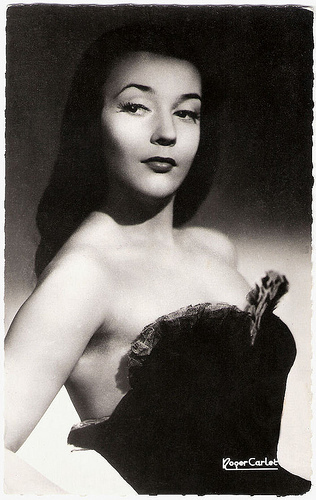
French postcard by Editions du Globe (EDUG), Paris, no. 116. Photo: Roger Carlet.
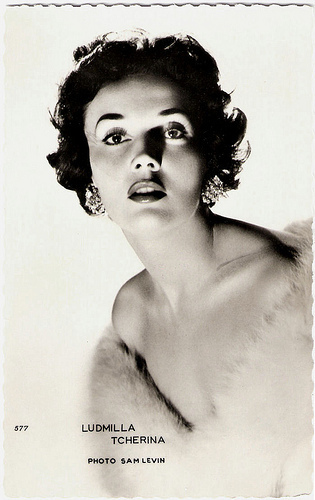
French postcard by Editions P.I., Paris, no. 577, offered by Les Carbones Korès. Photo: Sam Lévin.
Prima Ballerina
Ludmila or Ludmilla Tchérina was born as Monique Tchemerzine into Russian aristocracy in Paris, France, in 1924. She was the daughter of Circassian Prince Avenir Tchemerzine, a former general who had escaped from St. Petersburg, and Stéphane Finette, a Frenchwoman.
The family had little money, but Monique started ballet around the age of three, eventually studying with some of the greatest names in Paris - the former Maryinsky ballerina Olga Preobrajenska, and the former Bolshoi ballet master Ivan Clustine, the influential French teacher Gustave Ricaux.
Her first teacher, though, was Blanche D'Alessandri, who came from the strict Italian school and instilled technique with the help of taps on the body from a stick. This old-fashioned approach worked wonders.
After escaping with her mother to Marseilles at the start of the Second World War, she made her professional début at 15 and was a star dancer at the Opéra de Marseille at 16.
In 1943 she transferred to the Nouveaux Ballets de Monte Carlo where she was spotted by Serge Lifar , then director of the Paris Opéra Ballet. He invented her stage name, Ludmila Tchérina (used next to Ludmilla Tchérina), and choreographed Romeo and Juliet, to Tchaikovsky's Fantasy Overture, for himself and Tchérina, an extended pas de deux that was premiered at the Salle Pleyel in Paris in 1943.
In 1945 she was a principal dancer with the Ballet des Champs-Élysées and performed in Paris concerts with Edmond Audran, who became her husband in 1946. She created various roles in Lifar's ballets including: Mephisto Waltz in 1945, A la memoire d'un heros (In Memory of a Hero) in 1946 and in Le Martyre de Saint-Sebastian (The Martyrship of Saint Sebastian) in 1957.
She appeared often with the Paris Opera, the Bolshoi Ballet and the Kirov Ballet as a guest performer. Tchérina was 21 when she was offered her first film role in the French drama Un revenant/The Lover's Return (Christian-Jaque, 1946) starring Louis Jouvet and Gaby Morlay .
In 1948 she made her English-speaking film debut with the stylized fairy tale classic The Red Shoes (Michael Powell, Emeric Pressburger, 1948) featuring Moira Shearer and Marius Goring, but she did not understand what she was saying. She had to memorize her dialogue phonetically.
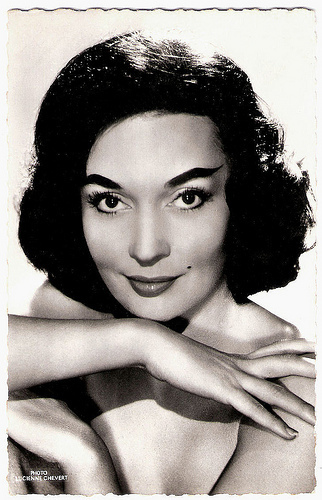
French postcard by Editions du Globe (EDUG), no. 621. Photo: Lucienne Chevert.
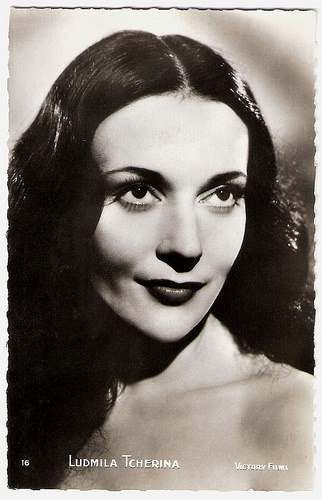
French postcard by Editions P.I., Paris, no. 16, offered by Les Carbones Korès. Photo: Victory Films.
Funeral March
Ludmila Tchérina won the French Cesar award for a short film version of Lifar’s ballet A La Memoire du Hero/In Memory of a Hero (Ray Ventura, 1951). In this film she portrayed Napoleon Bonaparte, dancing in travesty to the Funeral March of Beethoven's Eroica.
She went on to perform gloriously in The Tales of Hoffman (Michael Powell, Emeric Pressburger, 1951). Both of these films also featured her husband Edmond Audran. Shortly after the filming of The Tales of Hoffman, Audran was tragically killed in a road accident at age 33. The car accident left her shattered and the grief stricken Tchérina went into seclusion.
She was convinced to return to her art form in 1953 by her second husband Raymond Roi. He was a renowned French financier and industrialist, who remained her husband until her death in 2004.
Roi's wealth gave her the freedom to form her own experimental company which existed in 1958-1959 and appeared at the Théâtre Sarah-Bernhardt (now Théâtre de la Ville). For this, she commissioned Les Amants de Téruel, a dance theatre piece, devised by Raymond Rouleau and choreographed by Milko Sparemblek to a commissioned score by Mikis Theodorakis; and also Le Feu aux poudres (1958), which had a libretto by film director Jean Renoir and a choreography by Paul Goubé.
In 1960 she was the first Western dancer to appear at the Bolshoi Theatre and in 1970 she still enthralled audiences with her dance performance in Joan of Arc at the Stake.
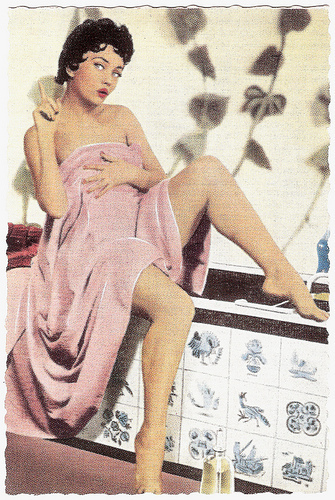
Small German collector's card by Druckerei Hanns Uhrig, Frankfurt a.M.. Photo: NF. Still from Oh... Rosalinda!! (1955).
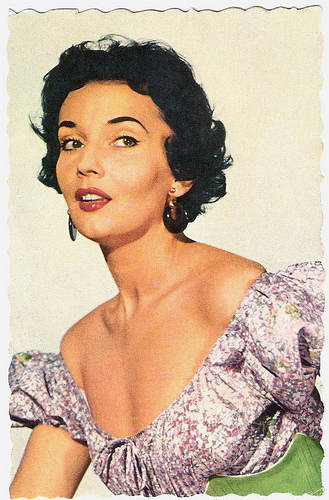
French postcard by Imp. De Marchi Frères, Marseille.
Breathing and Movement
The Tales of Hoffman had perked the eyes and ears of Hollywood, and Ludmila Tchérina made her American film début in Sign of the Pagan (Douglas Sirk, 1954), co-starring with Jeff Chandler and Jack Palance. In this film she performed a straight dramatic role along with an interpretative dance. This marked her first departure from classic ballet.
She also starred in the British Die Fledermaus adaptation Oh...Rosalinda!! (Michael Powell, Emeric Pressburger, 1955) with Anthony Quayle and Dennis Price , Luna de miel/Honeymoon (Michael Powell, 1959) with Anthony Steel , and the film version of Les amants de Teruel/The Lovers of Teruel (Raymond Rouleau, 1962).
She appeared less and less in films but regularly appeared in television shows. In the theatre she played Anna Karenina (1975), very dramatic in appearance and manner. On French television she starred in Salomé (1972), La Dame aux camélias (1974) and La Reine de Saba/The Queen of Sheeba (1975).
Ludmila Tchérina had a lifelong passion for painting and exhibited in many major galleries. In an exhibition at the Pompidou Center in Paris, she painted and danced in order to illustrate her concept of ‘total art’ in which all aspects are born of breathing and movement.
She also conceived and executed several monumental sculptures, including Europe à Coeur, chosen in 1991 by the EU to symbolize the union of Europe and now located at the European Parliament. In 1994 she created Europa Operanda, now installed at the French terminal of Eurotunnel.
In 1980 she was decorated Officier, Legion d'honneur in 1980. She authored two novels in the 1980s: L'amour au miroir (1983) and La femme a l'envers (1986).
Ludmila Tchérina died in 2004 after a long illness at her luxurious home in Paris.
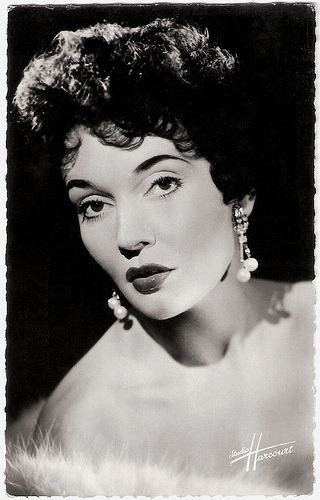
French postcard by Editions du Globe, Paris, no. 290. Photo: Studio Harcourt.
Scene from Fandango (Emil E.Reinert, 1949) with Luis Mariano and Ludmilla Tchérina. Source: ximowb (YouTube).
Sources: Nadine Meisner (The Independent), (IMDb), Wikipedia, and .

French postcard by Editions du Globe (EDUG), Paris, no. 116. Photo: Roger Carlet.

French postcard by Editions P.I., Paris, no. 577, offered by Les Carbones Korès. Photo: Sam Lévin.
Prima Ballerina
Ludmila or Ludmilla Tchérina was born as Monique Tchemerzine into Russian aristocracy in Paris, France, in 1924. She was the daughter of Circassian Prince Avenir Tchemerzine, a former general who had escaped from St. Petersburg, and Stéphane Finette, a Frenchwoman.
The family had little money, but Monique started ballet around the age of three, eventually studying with some of the greatest names in Paris - the former Maryinsky ballerina Olga Preobrajenska, and the former Bolshoi ballet master Ivan Clustine, the influential French teacher Gustave Ricaux.
Her first teacher, though, was Blanche D'Alessandri, who came from the strict Italian school and instilled technique with the help of taps on the body from a stick. This old-fashioned approach worked wonders.
After escaping with her mother to Marseilles at the start of the Second World War, she made her professional début at 15 and was a star dancer at the Opéra de Marseille at 16.
In 1943 she transferred to the Nouveaux Ballets de Monte Carlo where she was spotted by Serge Lifar , then director of the Paris Opéra Ballet. He invented her stage name, Ludmila Tchérina (used next to Ludmilla Tchérina), and choreographed Romeo and Juliet, to Tchaikovsky's Fantasy Overture, for himself and Tchérina, an extended pas de deux that was premiered at the Salle Pleyel in Paris in 1943.
In 1945 she was a principal dancer with the Ballet des Champs-Élysées and performed in Paris concerts with Edmond Audran, who became her husband in 1946. She created various roles in Lifar's ballets including: Mephisto Waltz in 1945, A la memoire d'un heros (In Memory of a Hero) in 1946 and in Le Martyre de Saint-Sebastian (The Martyrship of Saint Sebastian) in 1957.
She appeared often with the Paris Opera, the Bolshoi Ballet and the Kirov Ballet as a guest performer. Tchérina was 21 when she was offered her first film role in the French drama Un revenant/The Lover's Return (Christian-Jaque, 1946) starring Louis Jouvet and Gaby Morlay .
In 1948 she made her English-speaking film debut with the stylized fairy tale classic The Red Shoes (Michael Powell, Emeric Pressburger, 1948) featuring Moira Shearer and Marius Goring, but she did not understand what she was saying. She had to memorize her dialogue phonetically.

French postcard by Editions du Globe (EDUG), no. 621. Photo: Lucienne Chevert.

French postcard by Editions P.I., Paris, no. 16, offered by Les Carbones Korès. Photo: Victory Films.
Funeral March
Ludmila Tchérina won the French Cesar award for a short film version of Lifar’s ballet A La Memoire du Hero/In Memory of a Hero (Ray Ventura, 1951). In this film she portrayed Napoleon Bonaparte, dancing in travesty to the Funeral March of Beethoven's Eroica.
She went on to perform gloriously in The Tales of Hoffman (Michael Powell, Emeric Pressburger, 1951). Both of these films also featured her husband Edmond Audran. Shortly after the filming of The Tales of Hoffman, Audran was tragically killed in a road accident at age 33. The car accident left her shattered and the grief stricken Tchérina went into seclusion.
She was convinced to return to her art form in 1953 by her second husband Raymond Roi. He was a renowned French financier and industrialist, who remained her husband until her death in 2004.
Roi's wealth gave her the freedom to form her own experimental company which existed in 1958-1959 and appeared at the Théâtre Sarah-Bernhardt (now Théâtre de la Ville). For this, she commissioned Les Amants de Téruel, a dance theatre piece, devised by Raymond Rouleau and choreographed by Milko Sparemblek to a commissioned score by Mikis Theodorakis; and also Le Feu aux poudres (1958), which had a libretto by film director Jean Renoir and a choreography by Paul Goubé.
In 1960 she was the first Western dancer to appear at the Bolshoi Theatre and in 1970 she still enthralled audiences with her dance performance in Joan of Arc at the Stake.

Small German collector's card by Druckerei Hanns Uhrig, Frankfurt a.M.. Photo: NF. Still from Oh... Rosalinda!! (1955).

French postcard by Imp. De Marchi Frères, Marseille.
Breathing and Movement
The Tales of Hoffman had perked the eyes and ears of Hollywood, and Ludmila Tchérina made her American film début in Sign of the Pagan (Douglas Sirk, 1954), co-starring with Jeff Chandler and Jack Palance. In this film she performed a straight dramatic role along with an interpretative dance. This marked her first departure from classic ballet.
She also starred in the British Die Fledermaus adaptation Oh...Rosalinda!! (Michael Powell, Emeric Pressburger, 1955) with Anthony Quayle and Dennis Price , Luna de miel/Honeymoon (Michael Powell, 1959) with Anthony Steel , and the film version of Les amants de Teruel/The Lovers of Teruel (Raymond Rouleau, 1962).
She appeared less and less in films but regularly appeared in television shows. In the theatre she played Anna Karenina (1975), very dramatic in appearance and manner. On French television she starred in Salomé (1972), La Dame aux camélias (1974) and La Reine de Saba/The Queen of Sheeba (1975).
Ludmila Tchérina had a lifelong passion for painting and exhibited in many major galleries. In an exhibition at the Pompidou Center in Paris, she painted and danced in order to illustrate her concept of ‘total art’ in which all aspects are born of breathing and movement.
She also conceived and executed several monumental sculptures, including Europe à Coeur, chosen in 1991 by the EU to symbolize the union of Europe and now located at the European Parliament. In 1994 she created Europa Operanda, now installed at the French terminal of Eurotunnel.
In 1980 she was decorated Officier, Legion d'honneur in 1980. She authored two novels in the 1980s: L'amour au miroir (1983) and La femme a l'envers (1986).
Ludmila Tchérina died in 2004 after a long illness at her luxurious home in Paris.

French postcard by Editions du Globe, Paris, no. 290. Photo: Studio Harcourt.
Scene from Fandango (Emil E.Reinert, 1949) with Luis Mariano and Ludmilla Tchérina. Source: ximowb (YouTube).
Sources: Nadine Meisner (The Independent), (IMDb), Wikipedia, and .
Published on October 04, 2014 23:00
October 3, 2014
Die Nibelungen (1924)
Today starts the 33rd edition of the Giornate del Cinema Muto, which will take place in Pordenone, Italy, from 4 till 11 October. The Teatro Verdi will be the venue for 60 screenings of silent films. The main programme section is devoted to The Barrymores, Lionel, Ethel and John - the Royal Family of Broadway who brought prestige to 1920s Hollywood. The closing show of the festival is a live performance of City Lights (Charles Chaplin, 1931), with Chaplin's own score restored. There are exciting rediscoveries of films long considered lost, among them Lady Hamilton (Richard Oswald, 1921) with Conrad Veidt as Nelson, the sensational white-slave drama Das Frauenhaus von Rio/Girls for Sale! (Bud Pollard, Hans Steinhoff, 1927), and Die Macht der Finsternis/Power of Darkness (Conrad Wiene, 1924), a legendary adaptation of Tolstoy's drama. Another highlight is a marathon screening of both films of Fritz Lang's Die Nibelungen diptych, screened successively on the same afternoon and evening, and accompanied by Günter Buchwald (piano) and Frank Bockius (percussion). I can't attend the screening, but today's extra long film special honours this film and the Giornate del Cinema Muto.

German postcard by Ross Verlag, Berlin, no. 675/1. Photo: Decla-Ufa-Film. Publicity still for Die Nibelungen: Siegfried (Fritz Lang, 1924) with Paul Richter.

German postcard by Ross Verlag, no. 672/6. Photo: Decla-Ufa-Film. Publicity still for Die Nibelungen (Fritz Lang, 1924) with Margarethe Schön.

Italian postcard by Q. Vettori, Bologna.
How Siegfried Slayed the Dragon
Die Nibelungen (Fritz Lang, 1924) is one of the masterpieces of the Weimar cinema. Die Nibelungen is a duology of silent fantasy films: Die Nibelungen: Siegfried and Die Nibelungen: Kriemhilds Rache/Kriemhild's Revenge.
It was produced by the Ufa and Decla studios, and it starred Austrian actor Paul Richter as the (nearly) invulnerable hero Siegfried. Ross Verlag published in 1924 a beautiful series of sepia tinted postcards with stills of this classic film.
The screenplays were written by Fritz Lang and his wife at the time, Thea von Harbou. They were based upon the epic Nordic poem Nibelungenlied, written around AD 1200 and told through seven cantos.
It is the tale of the legendary German hero Siegfried ( Paul Richter ), son of King Siegmund. He masters the art of forging a sword at the shop of Mime (George John). On his journey home, he hears tales from the locals about Princess Kriemhild ( Margarete Schön ), the beautiful sister of King Gunter of Burgundy ( Theodor Loos ).
Siegfried decides to go to Worms, the capital of Burgundy, to win Kriemhild. On his journey to Worms, he is attacked by a dragon. Siegfried slays the dragon and bathes in his blood.
This bath makes him invulnerable - except for one spot on his shoulder blade which is missed after being covered by a falling lime leaf.

German postcard by Ross Verlag, no. 678/1. Photo: Decla / Ufa-Film. Publicity still for part I. of Die Nibelungen (Fritz Lang, 1924) with Paul Richter as Siegfried. Caption: Siegfrieds Kampf mit den Drachen (Siegfried's fight with the dragon).

German postcard by Ross Verlag, no. 678/2. Photo: Decla-Ufa-Film. Publicity still for Die Nibelungen: Siegfried (Fritz Lang, 1924). Caption: Siegfried's Fight with the Dragon.

German postcard by Ross Verlag, Berlin, no. 678/3. Photo: Decla-Ufa-Film. Caption: Siegfried's Fight with the Dragon.

German postcard by Ross Verlag, no. 678/4. Photo: Decla-Ufa-Film. Publicity still for Die Nibelungen: Siegfried (Fritz Lang, 1924). Caption: Siegfried bathes in the dragon's blood. After slaying the dragon, Siegfried (Paul Richter) bathes in the dragon's blood, which will make him invulnerable. Incidentally, a leaf falls on his back, creating Siegfried's one weak spot (his Achilles heel). When the vain and arrogant Paul Richter refused to strip for this scene, Lang called in the not so pretty Rudolf Klein-Rogge (Etzel - Attila - in the film), who immediately undressed and played the scene, to the dismay of Richter, as people now would identify Klein-Rogge's behind as his.
How Volker, the Bard, sang of Siegfried in front of Kriemhild, and How Siegfried Came in WormsSiegfried trespasses on the land of the Nibelungen and is attacked by Alberich, King of the Dwarves (again George John).
He fights and defeats Alberich who was wearing his wonder cloak of invisibility and transformation. Alberich asks Siegfried to spare his life and in return he gives the Treasure of the Nibelungen and the Balmung sword.
While Siegfried is mesmerised by the treasure, Alberich tries to defeat him, but dies in the attempt. Dying, Alberich curses all inheritors of the treasure and he and his dwarves turn to stone.
Siegfried makes twelve kings as his vassals, and arrives in Worms as a hero.

German postcard by Ross Verlag, Berlin, no. 675/2. Photo: Decla-Ufa-Film. Publicity still for Die Nibelungen: Siegfried (Fritz Lang, 1924). Caption: Siegfried and Alberich in the fog meadow.

German postcard by Ross Verlag, Berlin, no. 675/3. Photo: Decla-Ufa-Film. Publicity still for Die Nibelungen: Siegfried (1924, Fritz Lang) with Paul Richter as Siegfried and Georg John as Alberich. Caption: Siegfried and Alberich in the cave.

German postcard by Ross Verlag, Berlin, no. 672/1, 1924. Photo: Decla-Ufa-Film. Publicity still for Die Nibelungen: Siegfried (Fritz Lang, 1924).
How Siegfried Won Brunhild for Gunther
News reaches the court that Brunhild, a queen of outstanding strength and beauty may be won only by a man capable of matching her athletic prowess.
Gunther decides to woo Brunhild ( Hanna Ralph ) with the aid of Siegfried, to whom he promises the hand of Kriemhild if successful.
The men travel to Iceland, to the kingdom of Brunhild, where Siegfried feigns vassalage to Gunther so that he can avoid Brunhild's challenge.
He uses instead the cloak's power of invisibility to help Gunther beat the powerful Queen in a three-fold amazonian battle of strength: throwing stones, throwing a spear and jumping.

German postcard by Ross Verlag, Berlin, no. 673/3. Photo: Decla-Ufa-Film. Publicity still for Die Nibelungen: Siegfried (Fritz Lang, 1924).

German postcard by Ross Verlag, Berlin, no. 672/8. Photo: Decla-Ufa-Film. Publicity still for Die Nibelungen: Siegfried (Fritz Lang, 1924) with Hanna Ralph as Brunhild.
How Brunhild Enters Worms and How the King Celebrate Their Wedding
The men return to Burgundy where Gunther marries Brunhild and Siegfried weds Kriemhild.
Brunhild is not, however, completely defeated. She suspects deceit and says to Gunther that she is his captive but not his bride.
Hagen von Tronje ( Hans Adalbert Schlettow ) convinces Siegfried to help.
Siegfried transforms himself with the cloak into Gunther and battles Brunhild and removes her arm-ring during battle after which she submits to his will.
Siegfried leaves the real Gunther to consummate the marriage. Siegfried accidentally brings Brunhild's armlet with him.
On the postcard below Siegfried presents Kriemhild the circlet.

German postcard by Ross Verlag, Berlin, no. 675/6. Photo: Decla-Ufa-Film. Publicity still for Die Nibelungen: Siegfried (Fritz Lang, 1924). Caption: Siegfried greets Kriemhild.

German postcard by Ross Verlag, no. 673/1. Photo: Decla / Ufa-Film. Publicity still for Siegfried (Paul Richter) and Kriemhild (Margarete Schön) in part I. of Die Nibelungen (Fritz Lang, 1924).

German postcard by Ross Verlag, Berlin, no. 675/7. Photo: Decla-Ufa-Film. Publicity still for Die Nibelungen: Siegfried (Fritz Lang, 1924). Siegfried ( Paul Richter ) presents Kriemhild ( Margarete Schön ) the circlet.

German postcard by Ross Verlag, Berlin, no. 673/4. Photo: Decla-Ufa-Film. Publicity still for Die Nibelungen: Siegfried (Fritz Lang, 1924).
How After Half a Year, Siegfried's Gift to His Bride, The Nibelungen Treasure, Arrives in Worms and How the Two Queens Quarrel With Each Other
When Kriemhild finds Brunhild's armlet, Siegfried tells her how her brother won the queen.
When the Nibelungen treasure that Siegfried acquired from Alberich arrives at the court of Burgundy as Kriemhild's morning gift, the jealous Brunhild becomes more suspicious about Siegfried's feigned vassalage to Gunther.
Brunhild dons the Queen Mother's jewelery and proceeds to the cathedral to enter as the first person, as is her right as Queen of Burgundy.
Kriemhild and Brunhild quarrel. Brunhild ridicules Kriemhild for marrying a vassal, and Kriemhild reveals Siegfried’s and Gunther’s deception.

German postcard by Ross Verlag, Berlin, no. 672/7. Photo: Decla-Ufa-Film. Publicity still for Die Nibelungen: Siegfried (Fritz Lang, 1924) with Theodor Loos as Gunther.

German postcard by Ross Verlag, Berlin, no. 673/2. Photo: Decla-Ufa-Film. Publicity still for Die Nibelungen: Siegfried (Fritz Lang, 1924). Siegfried ( Paul Richter ) in the woods.

German postcard by Ross Verlag, Berlin, no. 675/5. Photo: Decla-Ufa-Film. Publicity still for Die Nibelungen, part I, Siegfried (Fritz Lang, 1924). Kriemhild (Margarete Schön) and the women in the 'kemenate', the heated private room of the castle, also called 'cabinet'.
How Gunther Betrayed Siegfried
Brunhild demands Siegfried to be killed.
She lies to Gunther and tells him that Siegfried stole her maidenhood when he battled her on her wedding night.
King Gunther and his uncle and loyal warrior, Hagen von Tronje ( Hans Adalbert Schlettow ), conspire to murder Siegfried during a hunt in the Odenwald Forest.
Hagen deceives Kriemhild into telling him the vulnerable part of Siegfried's body where the leaf has fallen.
She sews a cross on the spot in Siegfried's tunic.
After the hunt, Hagen challenges Siegfried to a race to a nearby spring.
When Siegfried is on his knees drinking, Hagen pierces him from behind with a spear.

German postcard by Ross Verlag, Berlin, no. 675/8. Photo: Decla-Ufa-Film. Publicity still for Die Nibelungen: Siegfried (Fritz Lang, 1924). Caption: Siegfried at the well.

German postcard by Uvachrome, serie 405, no. 5487. Photo: publicity still for Die Nibelungen: Siegfried (Fritz Lang, 1924).

German postcard by Ross Verlag, no. 673/6. Photo: Decla-Ufa-Film. Publicity still for Die Nibelungen (Fritz Lang, 1924) with Margarete Schön as Kriemhild near the corpse of Siegrfied ( Paul Richter ). She points at the murderer Hagen Tronje ( Hans Adalbert Schlettow ). Her brother, King Gunther ( Theodor Loos ), is standing next to her.
How Kriemhild Swears Revenge to Hagen Tronje
On the postcard below Kriemhild ( Margarete Schön ) and Brunhild ( Hanna Ralph ) mourn by the body of Siegfried ( Paul Richter ).
In an evil twist of bitter revenge, Brunhild confesses that she lied about Siegfried stealing her maidenhood in order to avenge Gunther's deceit of her. Gunther killed his only loyal friend.
Kriemhild demands her family avenge her husband's death at the hands of Siegfried, but her family is complicit in the murder, and so they protect Hagen.
Kriemhild swears revenge against Hagen while a guilt-ridden Brunhild commits suicide at the foot of Siegfried's corpse laid in state in the cathedral. Kriemhild swears revenge to Hagen.

German postcard by Ross Verlag, Berlin, no. 675/9. Photo: Decla-Ufa-Film. Publicity still for Die Nibelungen: Siegfried (Fritz Lang, 1924).

German postcard. Decla-Ufa-Film. Ross Verlag, no. 672/4. Bernhard Goetzke as Volker von Alzey, the bard in Die Nibelungen (1924).

German postcard by Ross Verlag, no. 672/2. Photo: Decla / Ufa-Film. Publicity still for part I. of Die Nibelungen (Fritz Lang, 1924) with Hans-Carl Müller as Gerenot von Burgund and Erwin Biswanger as Giselher von Burgund.

German postcard by Ross Verlag, no. 672/3. Photo: Decla / Ufa-Film. Publicity still for Die Nibelungen (Fritz Lang, 1924) with Gertrud Arnold as Queen Ute.

German postcard by Ross Verlag, Berlin, no. 672/5. Photo: Decla-Ufa-Film. Hans Adalbert Schlettow as Hagen (von) Tronje in Fritz Lang's saga Die Nibelungen (1924).
Kriemhild's Revenge
In the second film, Kriemhild's Rache/Kriemhild's Revenge, is shown how Kriemhild gets her revenge.
After Siegfried's dead, Kriemhild marries Etzel, the King of the Huns.
She gives birth to a child, and invites her brothers for a party.
She tries to persuade Etzel and the other Huns, that they kill Hagen, the murderer of Siegfried, but he is protected by her brothers.
A fierce battle begins to force her brothers to give Hagen to her.
Probably no literary work has given more to Germanic arts than the Nibelungenlied. Many variations and adaptations appeared through the centuries.
The most significant modern adaptation is Richard Wagner’s famous opera cycle Der Ring des Nibelungen (1853–1874).
The 1924 film Die Nibelungen is still astounding to look at. Fritz Lang gives the film a real sense of wonder by way of fantasy elements such as dwarfs, dragons and magic powers.
It's amazing that such a masterpiece of the cinema could have been made in the early 1920s.
The standout is the dragon-slaying scene with its wonderful special effects.

German postcard by Ross Verlag, no. 676/1. Photo: Decla-Ufa-Film. Publicity still for Die Nibelungen (Fritz Lang, 1924) with Margarete Schön as Kriemhild.

German postcard by Ross Verlag, Berlin, no. 676/2. Photo: Decla-Ufa-Film. Fritz Alberti as Dietrich von Bern in Fritz Lang's medieval saga Die Nibelungen (1924).

German postcard by Ross Verlag, no. 676/3. Photo: Decla / Ufa-Film. Publicity still for Die Nibelungen (Fritz Lang, 1924) with Georg August Koch as Hildebrand.

German postcard by Ross Verlag, no. 676/4. Photo:Decla-Ufa-Film. Rudolf Rittner as Rüdiger von Bechlaren in Fritz Lang's historical drama Die Nibelungen, part II (1924). The geometric patterns in the costumes and sets were inspired by book illustrations for a 1908-1909 edition of Die Nibelungen, edited at Gerlachs Jugendbücherei. These illustrations were by the Viennese artist Carl Otto Czeschka.

German postcard by Ross Verlag, no. 676/9. Photo: Decla-Ufa-Film. Rudolf Klein-Rogge as lord Etzel, king of the Huns, in Die Nibelungen (Fritz Lang, 1924), part II.

German postcard by Ross Verlag, no. 677/1. Photo: Decla-Ufa-Film. Publicity still for Die Nibelungen 2: Kriemhilds Rache/Die Nibelungen: Kriemhild's Revenge (Fritz Lang, 1924). The Betrothal of Giselher (Erwin Biswanger) and Dietlind (Annie Röttgen), led by her father Rüdiger von Bechlaren (Rudolf Rittner). To the right the Burgunds assist, including king Gunther ( Theodor Loos ), Hagen von Tronje ( Hans Adalbert Schlettow ) and Volker von Alzey ( Bernhard Goetzke ).

German postcard by Ross Verlag, Berlin, no. 677/2. Photo: Decla-Ufa-Film. Kriemhild (Margarete Schön) at the spring where Siegfried died. Publicity still for Die Nibelungen, part II, Kriemhilds Rache/Kriemhild's Revenge (Fritz Lang, 1924).

German postcard by Ross Verlag, no. 677/3. Photo: Decla-Ufa-Film. Publicity still for Die Nibelungen 2: Kriemhilds Rache/Die Nibelungen: Kriemhild's Revenge (Fritz Lang, 1924). At the beginning of Kriemhild's Rache Margrave Rüdiger von Bechlaren (Rudolf Ritttner) swears loyalty to the vengeful Kriemhild ( Margarete Schön ).

German postcard by Ross Verlag, no. 677/5. Photo: Decla-Ufa-Film. Publicity still for Die Nibelungen 2: Kriemhilds Rache/Die Nibelungen: Kriemhild's Revenge (Fritz Lang, 1924). Hagen von Tronje ( Hans Adalbert Schlettow ) dumps the Nibelungen treasure, that has been the cause of so much fight, jealousy and even murder.

German postcard by Ross Verlag, Berlin, no. 677/7. Photo: Decla-Ufa-Film. Publicity still for Die Nibelungen 2: Kriemhilds Rache/Die Nibelungen: Kriemhild's Revenge (Fritz Lang, 1924). Hagen von Tronje (Hans Adalbert Schlettow) protects king Gunther (Theodoor Loos) in the burning palace of Etzel.

German postcard by Ross Verlag, Berlin, no. 671/8. Photo: Decla-Ufa-Film. Publicity still for Die Nibelungen 2: Kriemhilds Rache/Die Nibelungen: Kriemhild's Revenge (Fritz Lang, 1924). Kriemhild ( Margarete Schön ) has got the deathblow. In the back, King Hetzel ( Rudolf Klein-Rogge ) looks on in astonishment.
See how Siegfried slays the dragon in Die Nibelungen (Fritz Lang, 1924). Source: Gtelloz (YouTube).
Sources: Claudio Carvalho (IMDb), Thomas Staedeli (Cyranos), Encyclopedia Britannica, IMDb and Wikipedia.

German postcard by Ross Verlag, Berlin, no. 675/1. Photo: Decla-Ufa-Film. Publicity still for Die Nibelungen: Siegfried (Fritz Lang, 1924) with Paul Richter.

German postcard by Ross Verlag, no. 672/6. Photo: Decla-Ufa-Film. Publicity still for Die Nibelungen (Fritz Lang, 1924) with Margarethe Schön.

Italian postcard by Q. Vettori, Bologna.
How Siegfried Slayed the Dragon
Die Nibelungen (Fritz Lang, 1924) is one of the masterpieces of the Weimar cinema. Die Nibelungen is a duology of silent fantasy films: Die Nibelungen: Siegfried and Die Nibelungen: Kriemhilds Rache/Kriemhild's Revenge.
It was produced by the Ufa and Decla studios, and it starred Austrian actor Paul Richter as the (nearly) invulnerable hero Siegfried. Ross Verlag published in 1924 a beautiful series of sepia tinted postcards with stills of this classic film.
The screenplays were written by Fritz Lang and his wife at the time, Thea von Harbou. They were based upon the epic Nordic poem Nibelungenlied, written around AD 1200 and told through seven cantos.
It is the tale of the legendary German hero Siegfried ( Paul Richter ), son of King Siegmund. He masters the art of forging a sword at the shop of Mime (George John). On his journey home, he hears tales from the locals about Princess Kriemhild ( Margarete Schön ), the beautiful sister of King Gunter of Burgundy ( Theodor Loos ).
Siegfried decides to go to Worms, the capital of Burgundy, to win Kriemhild. On his journey to Worms, he is attacked by a dragon. Siegfried slays the dragon and bathes in his blood.
This bath makes him invulnerable - except for one spot on his shoulder blade which is missed after being covered by a falling lime leaf.

German postcard by Ross Verlag, no. 678/1. Photo: Decla / Ufa-Film. Publicity still for part I. of Die Nibelungen (Fritz Lang, 1924) with Paul Richter as Siegfried. Caption: Siegfrieds Kampf mit den Drachen (Siegfried's fight with the dragon).

German postcard by Ross Verlag, no. 678/2. Photo: Decla-Ufa-Film. Publicity still for Die Nibelungen: Siegfried (Fritz Lang, 1924). Caption: Siegfried's Fight with the Dragon.

German postcard by Ross Verlag, Berlin, no. 678/3. Photo: Decla-Ufa-Film. Caption: Siegfried's Fight with the Dragon.

German postcard by Ross Verlag, no. 678/4. Photo: Decla-Ufa-Film. Publicity still for Die Nibelungen: Siegfried (Fritz Lang, 1924). Caption: Siegfried bathes in the dragon's blood. After slaying the dragon, Siegfried (Paul Richter) bathes in the dragon's blood, which will make him invulnerable. Incidentally, a leaf falls on his back, creating Siegfried's one weak spot (his Achilles heel). When the vain and arrogant Paul Richter refused to strip for this scene, Lang called in the not so pretty Rudolf Klein-Rogge (Etzel - Attila - in the film), who immediately undressed and played the scene, to the dismay of Richter, as people now would identify Klein-Rogge's behind as his.
How Volker, the Bard, sang of Siegfried in front of Kriemhild, and How Siegfried Came in WormsSiegfried trespasses on the land of the Nibelungen and is attacked by Alberich, King of the Dwarves (again George John).
He fights and defeats Alberich who was wearing his wonder cloak of invisibility and transformation. Alberich asks Siegfried to spare his life and in return he gives the Treasure of the Nibelungen and the Balmung sword.
While Siegfried is mesmerised by the treasure, Alberich tries to defeat him, but dies in the attempt. Dying, Alberich curses all inheritors of the treasure and he and his dwarves turn to stone.
Siegfried makes twelve kings as his vassals, and arrives in Worms as a hero.

German postcard by Ross Verlag, Berlin, no. 675/2. Photo: Decla-Ufa-Film. Publicity still for Die Nibelungen: Siegfried (Fritz Lang, 1924). Caption: Siegfried and Alberich in the fog meadow.

German postcard by Ross Verlag, Berlin, no. 675/3. Photo: Decla-Ufa-Film. Publicity still for Die Nibelungen: Siegfried (1924, Fritz Lang) with Paul Richter as Siegfried and Georg John as Alberich. Caption: Siegfried and Alberich in the cave.

German postcard by Ross Verlag, Berlin, no. 672/1, 1924. Photo: Decla-Ufa-Film. Publicity still for Die Nibelungen: Siegfried (Fritz Lang, 1924).
How Siegfried Won Brunhild for Gunther
News reaches the court that Brunhild, a queen of outstanding strength and beauty may be won only by a man capable of matching her athletic prowess.
Gunther decides to woo Brunhild ( Hanna Ralph ) with the aid of Siegfried, to whom he promises the hand of Kriemhild if successful.
The men travel to Iceland, to the kingdom of Brunhild, where Siegfried feigns vassalage to Gunther so that he can avoid Brunhild's challenge.
He uses instead the cloak's power of invisibility to help Gunther beat the powerful Queen in a three-fold amazonian battle of strength: throwing stones, throwing a spear and jumping.

German postcard by Ross Verlag, Berlin, no. 673/3. Photo: Decla-Ufa-Film. Publicity still for Die Nibelungen: Siegfried (Fritz Lang, 1924).

German postcard by Ross Verlag, Berlin, no. 672/8. Photo: Decla-Ufa-Film. Publicity still for Die Nibelungen: Siegfried (Fritz Lang, 1924) with Hanna Ralph as Brunhild.
How Brunhild Enters Worms and How the King Celebrate Their Wedding
The men return to Burgundy where Gunther marries Brunhild and Siegfried weds Kriemhild.
Brunhild is not, however, completely defeated. She suspects deceit and says to Gunther that she is his captive but not his bride.
Hagen von Tronje ( Hans Adalbert Schlettow ) convinces Siegfried to help.
Siegfried transforms himself with the cloak into Gunther and battles Brunhild and removes her arm-ring during battle after which she submits to his will.
Siegfried leaves the real Gunther to consummate the marriage. Siegfried accidentally brings Brunhild's armlet with him.
On the postcard below Siegfried presents Kriemhild the circlet.

German postcard by Ross Verlag, Berlin, no. 675/6. Photo: Decla-Ufa-Film. Publicity still for Die Nibelungen: Siegfried (Fritz Lang, 1924). Caption: Siegfried greets Kriemhild.

German postcard by Ross Verlag, no. 673/1. Photo: Decla / Ufa-Film. Publicity still for Siegfried (Paul Richter) and Kriemhild (Margarete Schön) in part I. of Die Nibelungen (Fritz Lang, 1924).

German postcard by Ross Verlag, Berlin, no. 675/7. Photo: Decla-Ufa-Film. Publicity still for Die Nibelungen: Siegfried (Fritz Lang, 1924). Siegfried ( Paul Richter ) presents Kriemhild ( Margarete Schön ) the circlet.

German postcard by Ross Verlag, Berlin, no. 673/4. Photo: Decla-Ufa-Film. Publicity still for Die Nibelungen: Siegfried (Fritz Lang, 1924).
How After Half a Year, Siegfried's Gift to His Bride, The Nibelungen Treasure, Arrives in Worms and How the Two Queens Quarrel With Each Other
When Kriemhild finds Brunhild's armlet, Siegfried tells her how her brother won the queen.
When the Nibelungen treasure that Siegfried acquired from Alberich arrives at the court of Burgundy as Kriemhild's morning gift, the jealous Brunhild becomes more suspicious about Siegfried's feigned vassalage to Gunther.
Brunhild dons the Queen Mother's jewelery and proceeds to the cathedral to enter as the first person, as is her right as Queen of Burgundy.
Kriemhild and Brunhild quarrel. Brunhild ridicules Kriemhild for marrying a vassal, and Kriemhild reveals Siegfried’s and Gunther’s deception.

German postcard by Ross Verlag, Berlin, no. 672/7. Photo: Decla-Ufa-Film. Publicity still for Die Nibelungen: Siegfried (Fritz Lang, 1924) with Theodor Loos as Gunther.

German postcard by Ross Verlag, Berlin, no. 673/2. Photo: Decla-Ufa-Film. Publicity still for Die Nibelungen: Siegfried (Fritz Lang, 1924). Siegfried ( Paul Richter ) in the woods.

German postcard by Ross Verlag, Berlin, no. 675/5. Photo: Decla-Ufa-Film. Publicity still for Die Nibelungen, part I, Siegfried (Fritz Lang, 1924). Kriemhild (Margarete Schön) and the women in the 'kemenate', the heated private room of the castle, also called 'cabinet'.
How Gunther Betrayed Siegfried
Brunhild demands Siegfried to be killed.
She lies to Gunther and tells him that Siegfried stole her maidenhood when he battled her on her wedding night.
King Gunther and his uncle and loyal warrior, Hagen von Tronje ( Hans Adalbert Schlettow ), conspire to murder Siegfried during a hunt in the Odenwald Forest.
Hagen deceives Kriemhild into telling him the vulnerable part of Siegfried's body where the leaf has fallen.
She sews a cross on the spot in Siegfried's tunic.
After the hunt, Hagen challenges Siegfried to a race to a nearby spring.
When Siegfried is on his knees drinking, Hagen pierces him from behind with a spear.

German postcard by Ross Verlag, Berlin, no. 675/8. Photo: Decla-Ufa-Film. Publicity still for Die Nibelungen: Siegfried (Fritz Lang, 1924). Caption: Siegfried at the well.

German postcard by Uvachrome, serie 405, no. 5487. Photo: publicity still for Die Nibelungen: Siegfried (Fritz Lang, 1924).

German postcard by Ross Verlag, no. 673/6. Photo: Decla-Ufa-Film. Publicity still for Die Nibelungen (Fritz Lang, 1924) with Margarete Schön as Kriemhild near the corpse of Siegrfied ( Paul Richter ). She points at the murderer Hagen Tronje ( Hans Adalbert Schlettow ). Her brother, King Gunther ( Theodor Loos ), is standing next to her.
How Kriemhild Swears Revenge to Hagen Tronje
On the postcard below Kriemhild ( Margarete Schön ) and Brunhild ( Hanna Ralph ) mourn by the body of Siegfried ( Paul Richter ).
In an evil twist of bitter revenge, Brunhild confesses that she lied about Siegfried stealing her maidenhood in order to avenge Gunther's deceit of her. Gunther killed his only loyal friend.
Kriemhild demands her family avenge her husband's death at the hands of Siegfried, but her family is complicit in the murder, and so they protect Hagen.
Kriemhild swears revenge against Hagen while a guilt-ridden Brunhild commits suicide at the foot of Siegfried's corpse laid in state in the cathedral. Kriemhild swears revenge to Hagen.

German postcard by Ross Verlag, Berlin, no. 675/9. Photo: Decla-Ufa-Film. Publicity still for Die Nibelungen: Siegfried (Fritz Lang, 1924).

German postcard. Decla-Ufa-Film. Ross Verlag, no. 672/4. Bernhard Goetzke as Volker von Alzey, the bard in Die Nibelungen (1924).

German postcard by Ross Verlag, no. 672/2. Photo: Decla / Ufa-Film. Publicity still for part I. of Die Nibelungen (Fritz Lang, 1924) with Hans-Carl Müller as Gerenot von Burgund and Erwin Biswanger as Giselher von Burgund.

German postcard by Ross Verlag, no. 672/3. Photo: Decla / Ufa-Film. Publicity still for Die Nibelungen (Fritz Lang, 1924) with Gertrud Arnold as Queen Ute.

German postcard by Ross Verlag, Berlin, no. 672/5. Photo: Decla-Ufa-Film. Hans Adalbert Schlettow as Hagen (von) Tronje in Fritz Lang's saga Die Nibelungen (1924).
Kriemhild's Revenge
In the second film, Kriemhild's Rache/Kriemhild's Revenge, is shown how Kriemhild gets her revenge.
After Siegfried's dead, Kriemhild marries Etzel, the King of the Huns.
She gives birth to a child, and invites her brothers for a party.
She tries to persuade Etzel and the other Huns, that they kill Hagen, the murderer of Siegfried, but he is protected by her brothers.
A fierce battle begins to force her brothers to give Hagen to her.
Probably no literary work has given more to Germanic arts than the Nibelungenlied. Many variations and adaptations appeared through the centuries.
The most significant modern adaptation is Richard Wagner’s famous opera cycle Der Ring des Nibelungen (1853–1874).
The 1924 film Die Nibelungen is still astounding to look at. Fritz Lang gives the film a real sense of wonder by way of fantasy elements such as dwarfs, dragons and magic powers.
It's amazing that such a masterpiece of the cinema could have been made in the early 1920s.
The standout is the dragon-slaying scene with its wonderful special effects.

German postcard by Ross Verlag, no. 676/1. Photo: Decla-Ufa-Film. Publicity still for Die Nibelungen (Fritz Lang, 1924) with Margarete Schön as Kriemhild.

German postcard by Ross Verlag, Berlin, no. 676/2. Photo: Decla-Ufa-Film. Fritz Alberti as Dietrich von Bern in Fritz Lang's medieval saga Die Nibelungen (1924).

German postcard by Ross Verlag, no. 676/3. Photo: Decla / Ufa-Film. Publicity still for Die Nibelungen (Fritz Lang, 1924) with Georg August Koch as Hildebrand.

German postcard by Ross Verlag, no. 676/4. Photo:Decla-Ufa-Film. Rudolf Rittner as Rüdiger von Bechlaren in Fritz Lang's historical drama Die Nibelungen, part II (1924). The geometric patterns in the costumes and sets were inspired by book illustrations for a 1908-1909 edition of Die Nibelungen, edited at Gerlachs Jugendbücherei. These illustrations were by the Viennese artist Carl Otto Czeschka.

German postcard by Ross Verlag, no. 676/9. Photo: Decla-Ufa-Film. Rudolf Klein-Rogge as lord Etzel, king of the Huns, in Die Nibelungen (Fritz Lang, 1924), part II.

German postcard by Ross Verlag, no. 677/1. Photo: Decla-Ufa-Film. Publicity still for Die Nibelungen 2: Kriemhilds Rache/Die Nibelungen: Kriemhild's Revenge (Fritz Lang, 1924). The Betrothal of Giselher (Erwin Biswanger) and Dietlind (Annie Röttgen), led by her father Rüdiger von Bechlaren (Rudolf Rittner). To the right the Burgunds assist, including king Gunther ( Theodor Loos ), Hagen von Tronje ( Hans Adalbert Schlettow ) and Volker von Alzey ( Bernhard Goetzke ).

German postcard by Ross Verlag, Berlin, no. 677/2. Photo: Decla-Ufa-Film. Kriemhild (Margarete Schön) at the spring where Siegfried died. Publicity still for Die Nibelungen, part II, Kriemhilds Rache/Kriemhild's Revenge (Fritz Lang, 1924).

German postcard by Ross Verlag, no. 677/3. Photo: Decla-Ufa-Film. Publicity still for Die Nibelungen 2: Kriemhilds Rache/Die Nibelungen: Kriemhild's Revenge (Fritz Lang, 1924). At the beginning of Kriemhild's Rache Margrave Rüdiger von Bechlaren (Rudolf Ritttner) swears loyalty to the vengeful Kriemhild ( Margarete Schön ).

German postcard by Ross Verlag, no. 677/5. Photo: Decla-Ufa-Film. Publicity still for Die Nibelungen 2: Kriemhilds Rache/Die Nibelungen: Kriemhild's Revenge (Fritz Lang, 1924). Hagen von Tronje ( Hans Adalbert Schlettow ) dumps the Nibelungen treasure, that has been the cause of so much fight, jealousy and even murder.

German postcard by Ross Verlag, Berlin, no. 677/7. Photo: Decla-Ufa-Film. Publicity still for Die Nibelungen 2: Kriemhilds Rache/Die Nibelungen: Kriemhild's Revenge (Fritz Lang, 1924). Hagen von Tronje (Hans Adalbert Schlettow) protects king Gunther (Theodoor Loos) in the burning palace of Etzel.

German postcard by Ross Verlag, Berlin, no. 671/8. Photo: Decla-Ufa-Film. Publicity still for Die Nibelungen 2: Kriemhilds Rache/Die Nibelungen: Kriemhild's Revenge (Fritz Lang, 1924). Kriemhild ( Margarete Schön ) has got the deathblow. In the back, King Hetzel ( Rudolf Klein-Rogge ) looks on in astonishment.
See how Siegfried slays the dragon in Die Nibelungen (Fritz Lang, 1924). Source: Gtelloz (YouTube).
Sources: Claudio Carvalho (IMDb), Thomas Staedeli (Cyranos), Encyclopedia Britannica, IMDb and Wikipedia.
Published on October 03, 2014 23:00
October 2, 2014
Mary Odette
At the final day of the Nederlands Film Festival (24 September - 3 October 2014), EFSP presents in the unofficial Dutch Film Star Postcards Festival an odd post. Mary Odette (1901-1987) or Odette Goimbault was not a Dutch but a French actress, who starred in British, German and French silent films. But she also appeared in several Dutch films produced by the Hollandia Filmfabriek, which made her a star in the Netherlands. In Germany, she also worked with Dutch director Jaap Speyer.
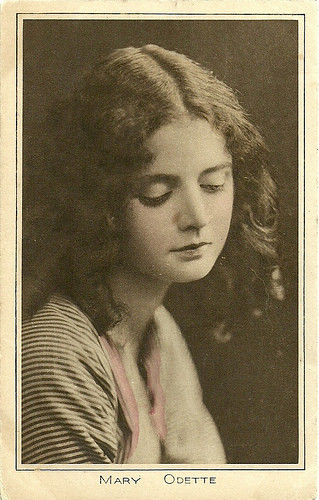
British postcard by Pictures Ltd., London, in the Pictures Portrait Gallery series, no. 49. Photo: Claude Harris.
Hollandia star
Mary Odette was born Odette Goimbault on 10 August 1901 in Dieppe, France. When she was still a child her parents moved with her to Britain.
As a teenager she debuted on the London stage and started in British cinema under her real name, in the film Cynthia in the Wilderness (Harold Weston, 1916), starring Eve Balfour.
From 1918 she had an intense career in British silent cinema, until 1919 still under own name, and often in the female lead. Her British films included The Greatest Wish in the World (Maurice Elvey, 1918), Spinner O’Dreams (Wilfred Noy, 1918), The Wages of Sin (Arrigo Bocchi, 1918), and Peace, Perfect Peace (Arrigo Bocchi, 1918), released just after the armistice ending the First World War.
In the latter film Goimbault’s character had the name of Marie Odette, a name she started to use as her own from 1919 on, first with Castle of Dreams (Wilfred Noy, 1919).
In 1920, she played opposite the reputed French actor Henry Krauss in Enchantment (Einar Bruun, 1920), also with Eric Barclay.
The same year she got an offer to act in the Netherlands at the company Hollandia, which was making co-productions with Britain.
Odette starred here in Zoo als ik ben/As God Made Her (Maurits Binger, B.E. Doxat-Pratt, 1920), and De vrouw van de minister/John Heriott’s Wife (Maurits Binger, B.E. Doxat-Pratt, 1920).
In both films, she co-starred with Adelqui Migliar , Lola Cornero and Henry Victor. One of the other actresses in the cast was the former Dutch diva Annie Bos, named Anna Bosilova here.
Odette rose to star status in the Netherlands and she also managed to convince British actress Elsie Cohen to come over and work for Hollandia.
Yet, she herself soon returned to Britain where she continued to act in films mainly directed by Kenelm Foss, but also in e.g. The Hypocrites (Charles Giblyn, 1923).
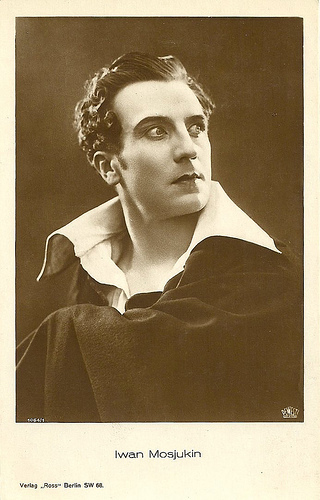
Ivan Mozzhukhin . German postcard by Ross Verlag, no. 1064/1, 1927-1928. Photo: DeWesti Film-Verleih. Publicity still for the film Kean/Kean ou désordre et génie (Alexandre Volkoff, 1924).
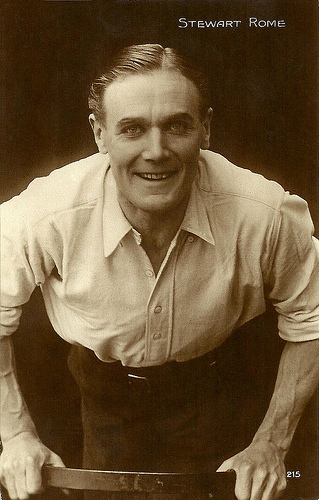
Stewart Rome
Jaap Speyer
In 1923, Mary Odette went to Berlin, where she acted with Stewart Rome in Im Schatten der Moschee (Walter Richard Hall, 1923).
Then she returned to Holland to act in De leeuw en de muis/The Lion’s Mouse (Oscar Apfel, 1923). The film co-starred Marguerite Marsh, a sister of famous American actress Mae Marsh, who died at a very young age because of pneumonia.
Around the same time, Odette acted in France in the period piece Kean/Kean ou désordre et génie (1924) by Alexandre Volkoff and starring Ivan Mozzhukhin as the legendary British actor Edmund Kean.
In 1925, Odette played in Berlin in Max Mack’s Vater Voss, with Stewart Rome , and also in the British-German co-production She (Leander De Cordova, 1925), starring Betty Blythe and Carlyle Blackwell. This H. Rider Haggard adaptation was shot in a German zeppelin hall.
With Blythe she also acted in the German version of She, called Mirakel der Liebe (Leander De Cordova, 1925).
Odette continued to act in Germany in Elegantes Pack (1925) by Dutch director Jaap Speyer, opposite Eugen Klöpfer, Ralph Arthur Roberts and Hanni Weisse , and in Die Moral der Gasse (Jaap Speyer 1925), with Werner Krauss , Ernst Hofmann and Evi Eva .
Her last silent films were Emerald of the East (Jean de Kucharski, 1928), and Celle qui domine (Carmine Gallone, Léon Mathot, 1929), starring Léon Mathot himself and Soava Gallone .
At the end of the silent era, Odette didn’t manage to switch to sound cinema and retired from screen acting.
She married a journalist, first moved with him to India, then returned to Britain.
Mary Odette died in Stockport, UK, in 1987. She was 85.
Sources: Cineressources (French), Filmportal.de, Wikipedia (Dutch, German, English and French), and .

British postcard by Pictures Ltd., London, in the Pictures Portrait Gallery series, no. 49. Photo: Claude Harris.
Hollandia star
Mary Odette was born Odette Goimbault on 10 August 1901 in Dieppe, France. When she was still a child her parents moved with her to Britain.
As a teenager she debuted on the London stage and started in British cinema under her real name, in the film Cynthia in the Wilderness (Harold Weston, 1916), starring Eve Balfour.
From 1918 she had an intense career in British silent cinema, until 1919 still under own name, and often in the female lead. Her British films included The Greatest Wish in the World (Maurice Elvey, 1918), Spinner O’Dreams (Wilfred Noy, 1918), The Wages of Sin (Arrigo Bocchi, 1918), and Peace, Perfect Peace (Arrigo Bocchi, 1918), released just after the armistice ending the First World War.
In the latter film Goimbault’s character had the name of Marie Odette, a name she started to use as her own from 1919 on, first with Castle of Dreams (Wilfred Noy, 1919).
In 1920, she played opposite the reputed French actor Henry Krauss in Enchantment (Einar Bruun, 1920), also with Eric Barclay.
The same year she got an offer to act in the Netherlands at the company Hollandia, which was making co-productions with Britain.
Odette starred here in Zoo als ik ben/As God Made Her (Maurits Binger, B.E. Doxat-Pratt, 1920), and De vrouw van de minister/John Heriott’s Wife (Maurits Binger, B.E. Doxat-Pratt, 1920).
In both films, she co-starred with Adelqui Migliar , Lola Cornero and Henry Victor. One of the other actresses in the cast was the former Dutch diva Annie Bos, named Anna Bosilova here.
Odette rose to star status in the Netherlands and she also managed to convince British actress Elsie Cohen to come over and work for Hollandia.
Yet, she herself soon returned to Britain where she continued to act in films mainly directed by Kenelm Foss, but also in e.g. The Hypocrites (Charles Giblyn, 1923).

Ivan Mozzhukhin . German postcard by Ross Verlag, no. 1064/1, 1927-1928. Photo: DeWesti Film-Verleih. Publicity still for the film Kean/Kean ou désordre et génie (Alexandre Volkoff, 1924).

Stewart Rome
Jaap Speyer
In 1923, Mary Odette went to Berlin, where she acted with Stewart Rome in Im Schatten der Moschee (Walter Richard Hall, 1923).
Then she returned to Holland to act in De leeuw en de muis/The Lion’s Mouse (Oscar Apfel, 1923). The film co-starred Marguerite Marsh, a sister of famous American actress Mae Marsh, who died at a very young age because of pneumonia.
Around the same time, Odette acted in France in the period piece Kean/Kean ou désordre et génie (1924) by Alexandre Volkoff and starring Ivan Mozzhukhin as the legendary British actor Edmund Kean.
In 1925, Odette played in Berlin in Max Mack’s Vater Voss, with Stewart Rome , and also in the British-German co-production She (Leander De Cordova, 1925), starring Betty Blythe and Carlyle Blackwell. This H. Rider Haggard adaptation was shot in a German zeppelin hall.
With Blythe she also acted in the German version of She, called Mirakel der Liebe (Leander De Cordova, 1925).
Odette continued to act in Germany in Elegantes Pack (1925) by Dutch director Jaap Speyer, opposite Eugen Klöpfer, Ralph Arthur Roberts and Hanni Weisse , and in Die Moral der Gasse (Jaap Speyer 1925), with Werner Krauss , Ernst Hofmann and Evi Eva .
Her last silent films were Emerald of the East (Jean de Kucharski, 1928), and Celle qui domine (Carmine Gallone, Léon Mathot, 1929), starring Léon Mathot himself and Soava Gallone .
At the end of the silent era, Odette didn’t manage to switch to sound cinema and retired from screen acting.
She married a journalist, first moved with him to India, then returned to Britain.
Mary Odette died in Stockport, UK, in 1987. She was 85.
Sources: Cineressources (French), Filmportal.de, Wikipedia (Dutch, German, English and French), and .
Published on October 02, 2014 23:00
October 1, 2014
Eduard Verkade
Today is the fifth day of the 2014
Nederlands Film Festival
in Utrecht. In the unofficial Dutch film star postcards festival, we present you Eduard Verkade (1878-1961). He was one of the actor-directors who revolutionized the Dutch theatre in the first decades of the 20th century. Verkade broke with the histrionics and the historic realism of the preceding period. As an actor he was especially renowned for his numerous solo-performances of Macbeth and Hamlet. He also starred in Dutch films of the 1910s, 1920s and the 1930s.
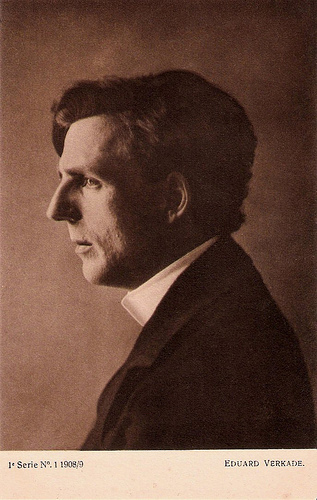
Dutch postcard, 1st series, no. 1, 1908/9.
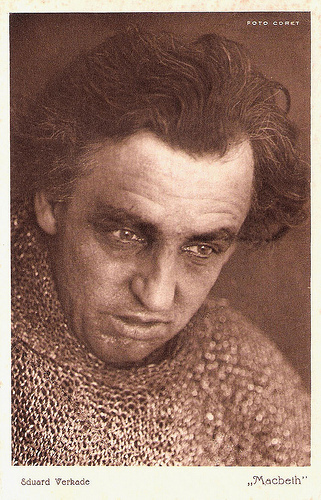
Dutch postcard. Photo: Willem Coret, Den Haag (The Hague). Still of Eduard Verkade as MacBeth in the play by William Shakespeare.
Biscuits and Chocolate
Eduard Rutger Verkade was born in Amsterdam, the Netherlands in 1878.
He studied in 1894 at the Finsbury College near Londen. His studies were meant for a managerial job at his father’s famous biscuits and chocolate factory in the Netherlands, Verkade. In London he attended many theatre performances and in 1904 he decided for a stage career.
In 1908 he started his own theatre group, Die Haghespelers. This theatre company would exist till 1936 and staged a.o. William Shakespeare's Hamlet and Macbeth, which would become the most famous roles of Eduard Verkade.
He also acted in classic plays by Joost van den Vondel, Maurice Maeterlinck, and in Fyodor Dostoyevsky’s The Brothers Karamazov.
In the meantime he would work as the artistic director of numerous theatre companies and as a director he was an important innovator. In the 1930s he would also be the theatre critic for the prolific Dutch magazine De Groene Amsterdammer.
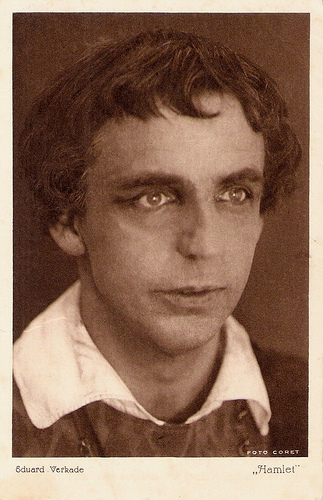
Dutch postcard. Photo: Willem Coret, The Hague. Still of Eduard Verkade as Hamlet in the play by William Shakespeare.
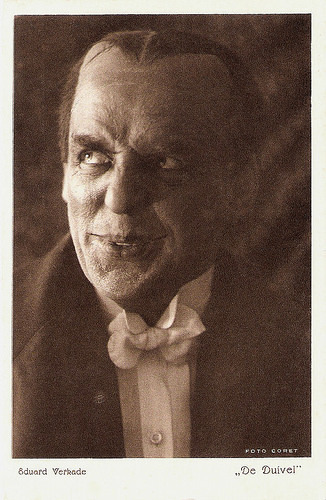
Dutch postcard. Photo: Coret, Den Haag. Picture of Eduard Verkade as the Devil in the stage play De Duivel (Az Ördög/The Devil) by Ferenc Molnár.
Devil in Amsterdam
Eduard Verkade starred in several Dutch films. In the silent film De duivel in Amsterdam/The Devil in Amsterdam (Theo Frenkel, 1919), based on the play Az ördög (The Devil, 1907) by Ferenc Molnár, he played the devil. His co-star was another legend of the Dutch stage, Louis Bouwmeester . The film is considered as lost.
In another silent film, the Alexandre Dumas adaptation De zwarte tulp/The Black Tulip (Maurits Binger, Frank Richardson, 1921), he played the historical politician Cornelis de Witt.
His biggest film hit was the Dutch film version of G.B. Shaw's Pygmalion (Ludwig Berger, 1937), in which he played the role of Pickering.
The star was Dutch diva Lily Bouwmeester, and soon he played in two more films with her: Veertig jaren/Forty Years (Edmond T. Gréville, 1938) and Ergens in Nederland/Somewhere in the Netherlands (Ludwig Berger, 1940).
In Ergens in Nederland/Somewhere in the Netherlands also appeared the author Jan de Hertog and Fien de la Mar . The film was just ready for release when the Netherlands were conquered by the Nazis, who forbade its exhibition.
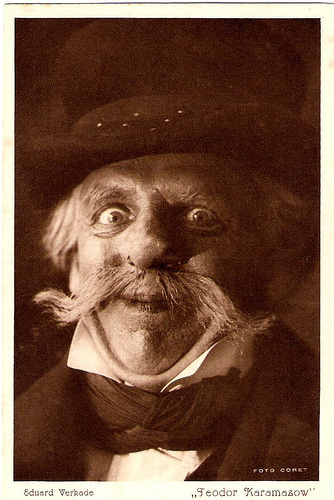
Dutch postcard. Photo: Willem Coret, Den Haag. Still of Eduard Verkade in his stage role as Feodor Karamazow.
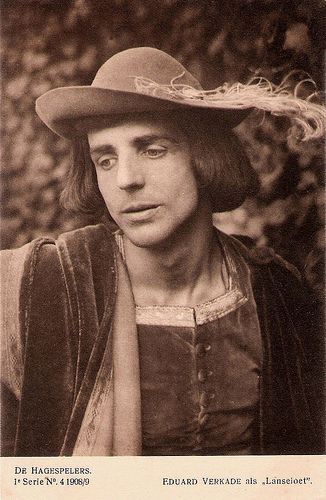
Dutch postcard, 1st series, no. 4, 1908/9. Photo: still of Eduard Verkade as Lanseloet in a stage production by Die Haghespelers of the medieval play Lanseloet van Denemerken (Lancelot of Denmark).
Dangerous sentiments
During WW II, Eduard Verkade refused to join the Kulturkammer (the Nazi Ministry of Culture, which held under close scrutiny all artistic practices).
He was considered suspect because of his ‘dangerous’ pro-English sentiments. He saw in William Shakespeare's plays a powerful vehicle for anti-German - or, more generally, anti-war - protest.
He was also the organiser of many 'black evenings’ - clandestine theatre performances held at people's private homes, with the residents, their family and neighbours as the audience.
His house was a hiding place for many people, including the poet Adriaan Roland Holst.
In 1947 Eduard Verkade retired, and in 1961 he died in Breukelen, The Netherlands.
He was married four times. His wives were Johanna van Wulfften Palthe (1902-1910; two sons and a daughter); Maria Magdalena Müller (a.k.a. actress Enny Vrede)(1910-1919; a daughter and a son); Marie Cramer (a.k.a. author and illustrator Rie Cramer) (1922-1933); and Eline Françoise Cartier van Dissel (1935-1961). Eduard Verkade also had a son (1921) with Henriette Jacoba Maria Carolina Croes.
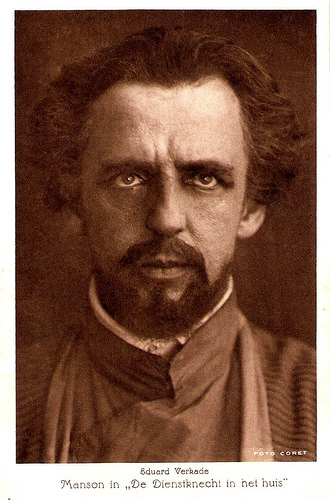
Dutch postcard, 1926. Photo: Willem Coret, Den Haag. Still of Eduard Verkade as Manson in the stage play De dienstknecht in het huis/The Servant in the House by Charles Rann Kennedy.
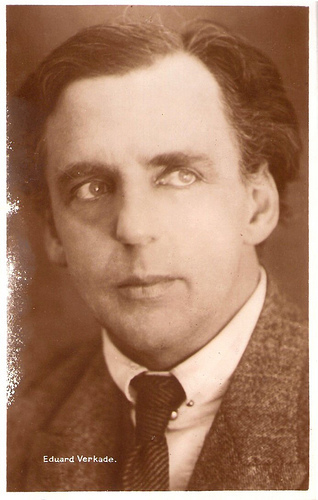
Dutch postcard by Weenenk & Snel, Den Haag. Photo: Willem Coret, Den Haag. Collection: Egbert Barten.
Sources: H.H.J. de Leeuwe (Huygens ING), Ruud van Capelleveen (Abolute Facts), Wikipedia (Dutch) and .

Dutch postcard, 1st series, no. 1, 1908/9.

Dutch postcard. Photo: Willem Coret, Den Haag (The Hague). Still of Eduard Verkade as MacBeth in the play by William Shakespeare.
Biscuits and Chocolate
Eduard Rutger Verkade was born in Amsterdam, the Netherlands in 1878.
He studied in 1894 at the Finsbury College near Londen. His studies were meant for a managerial job at his father’s famous biscuits and chocolate factory in the Netherlands, Verkade. In London he attended many theatre performances and in 1904 he decided for a stage career.
In 1908 he started his own theatre group, Die Haghespelers. This theatre company would exist till 1936 and staged a.o. William Shakespeare's Hamlet and Macbeth, which would become the most famous roles of Eduard Verkade.
He also acted in classic plays by Joost van den Vondel, Maurice Maeterlinck, and in Fyodor Dostoyevsky’s The Brothers Karamazov.
In the meantime he would work as the artistic director of numerous theatre companies and as a director he was an important innovator. In the 1930s he would also be the theatre critic for the prolific Dutch magazine De Groene Amsterdammer.

Dutch postcard. Photo: Willem Coret, The Hague. Still of Eduard Verkade as Hamlet in the play by William Shakespeare.

Dutch postcard. Photo: Coret, Den Haag. Picture of Eduard Verkade as the Devil in the stage play De Duivel (Az Ördög/The Devil) by Ferenc Molnár.
Devil in Amsterdam
Eduard Verkade starred in several Dutch films. In the silent film De duivel in Amsterdam/The Devil in Amsterdam (Theo Frenkel, 1919), based on the play Az ördög (The Devil, 1907) by Ferenc Molnár, he played the devil. His co-star was another legend of the Dutch stage, Louis Bouwmeester . The film is considered as lost.
In another silent film, the Alexandre Dumas adaptation De zwarte tulp/The Black Tulip (Maurits Binger, Frank Richardson, 1921), he played the historical politician Cornelis de Witt.
His biggest film hit was the Dutch film version of G.B. Shaw's Pygmalion (Ludwig Berger, 1937), in which he played the role of Pickering.
The star was Dutch diva Lily Bouwmeester, and soon he played in two more films with her: Veertig jaren/Forty Years (Edmond T. Gréville, 1938) and Ergens in Nederland/Somewhere in the Netherlands (Ludwig Berger, 1940).
In Ergens in Nederland/Somewhere in the Netherlands also appeared the author Jan de Hertog and Fien de la Mar . The film was just ready for release when the Netherlands were conquered by the Nazis, who forbade its exhibition.

Dutch postcard. Photo: Willem Coret, Den Haag. Still of Eduard Verkade in his stage role as Feodor Karamazow.

Dutch postcard, 1st series, no. 4, 1908/9. Photo: still of Eduard Verkade as Lanseloet in a stage production by Die Haghespelers of the medieval play Lanseloet van Denemerken (Lancelot of Denmark).
Dangerous sentiments
During WW II, Eduard Verkade refused to join the Kulturkammer (the Nazi Ministry of Culture, which held under close scrutiny all artistic practices).
He was considered suspect because of his ‘dangerous’ pro-English sentiments. He saw in William Shakespeare's plays a powerful vehicle for anti-German - or, more generally, anti-war - protest.
He was also the organiser of many 'black evenings’ - clandestine theatre performances held at people's private homes, with the residents, their family and neighbours as the audience.
His house was a hiding place for many people, including the poet Adriaan Roland Holst.
In 1947 Eduard Verkade retired, and in 1961 he died in Breukelen, The Netherlands.
He was married four times. His wives were Johanna van Wulfften Palthe (1902-1910; two sons and a daughter); Maria Magdalena Müller (a.k.a. actress Enny Vrede)(1910-1919; a daughter and a son); Marie Cramer (a.k.a. author and illustrator Rie Cramer) (1922-1933); and Eline Françoise Cartier van Dissel (1935-1961). Eduard Verkade also had a son (1921) with Henriette Jacoba Maria Carolina Croes.

Dutch postcard, 1926. Photo: Willem Coret, Den Haag. Still of Eduard Verkade as Manson in the stage play De dienstknecht in het huis/The Servant in the House by Charles Rann Kennedy.

Dutch postcard by Weenenk & Snel, Den Haag. Photo: Willem Coret, Den Haag. Collection: Egbert Barten.
Sources: H.H.J. de Leeuwe (Huygens ING), Ruud van Capelleveen (Abolute Facts), Wikipedia (Dutch) and .
Published on October 01, 2014 23:00
Paul van Yperen's Blog
- Paul van Yperen's profile
- 13 followers
Paul van Yperen isn't a Goodreads Author
(yet),
but they
do have a blog,
so here are some recent posts imported from
their feed.



